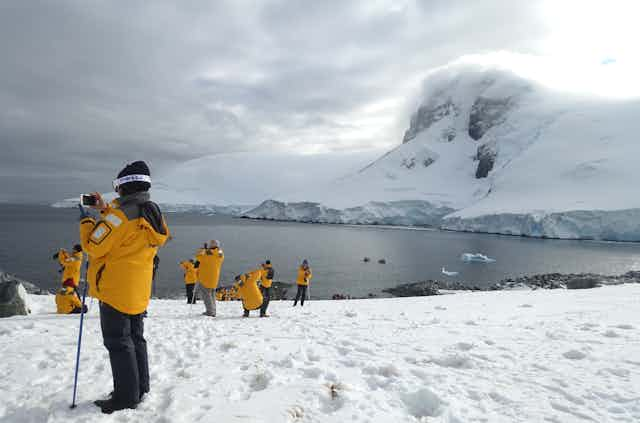

More than 100,000 tourists will head to Antarctica this summer. Should we worry about damage to the ice and its ecosystems?
Professor of English and Associate Dean, Research Performance, University of Tasmania
Associate Professor, Tourism and Society, University of Tasmania
Professor, University of Tasmania
Senior Lecturer in Musicology, Conservatorium of Music, School of Creative Arts and Media; Adjunct Senior Researcher, Institute for Marine and Antarctic Studies, University of Tasmania, University of Tasmania
Lecturer, University of Tasmania
PhD Candidate, Centre for Marine Socioecology, University of Tasmania
Disclosure statement
Elizabeth Leane receives funding from the Australian Research Council LP190101116, which also includes funding from partner organisation Intrepid Travel, and DP220103005; the Dutch Research Council (NWA.1435.20.001); and the Australian Antarctic Division. Hurtigruten Australia provide in-kind support for fieldwork.
Anne Hardy receives funding from the Australian Research Council (LP190101116) and the Dutch Research Council (NWA.1435.20.001), and Hurtigruten Australia provide in-kind support for fieldwork.
Can Seng Ooi receives funding from the Australian Research Council LP190101116, which also includes funding and in-kind support for fieldwork from partner organisation Intrepid Travel.
Carolyn Philpott receives funding from the Australian Research Council LP190101116, which also includes funding and in-kind support for fieldwork from partner organisation Intrepid Travel, and DP220103005.
Hanne E.F. Nielsen receives funding from the Australian Research Council LP190101116, which also includes funding from partner organisation Intrepid Travel, and DP220103005; the Dutch Research Council (NWA.1435.20.001); and the Australian Antarctic Division. Hurtigruten Australia provide in-kind support for fieldwork.
Katie Marx works on a contract basis as an on-board lecturer and guide for an Antarctic tourism operator. She receives funding from the Australian Research Council LP190101116, which also includes funding and in-kind support for fieldwork from partner organisation Intrepid Travel.
University of Tasmania provides funding as a member of The Conversation AU.
View all partners
As the summer sun finally arrives for people in the Southern Hemisphere, more than 100,000 tourists will head for the ice. Travelling on one of more than 50 cruise ships, they will brave the two-day trip across the notoriously rough Drake Passage below Patagonia, destined for the polar continent of Antarctica.
During the COVID summer of 2020-21, just 15 tourists on two yachts visited Antarctica. But now, tourism is back – and bigger than ever. This season’s visitor numbers are up more than 40% over the largest pre-pandemic year .
So are all those tourists going to damage what is often considered the last untouched wilderness on the planet? Yes and no. The industry is well run. Tourists often return with a new appreciation for wild places. They spend a surprisingly short amount of time actually on the continent or its islands.
But as tourism grows, so will environmental impacts such as black carbon from cruise ship funnels. Tourists can carry in microbes, seed and other invasive species on their boots and clothes – a problem that will only worsen as ice melt creates new patches of bare earth. And cruise ships are hardly emissions misers.

How did Antarctic tourism go mainstream?
In the 1950s, the first tourists hitched rides on Chilean and Argentinian naval vessels heading south to resupply research bases on the South Shetland Islands. From the late 1960s, dedicated icebreaker expedition ships were venturing even further south. In the early 1990s, as ex-Soviet icebreakers became available, the industry began to expand – about a dozen companies offered trips at that time. By the turn of this century, the ice continent was receiving more than 10,000 annual visitors: Antarctic tourism had gone mainstream.
What does it look like today?
Most Antarctic tourists travel on small “expedition-style” vessels, usually heading for the relatively accessible Antarctic Peninsula. Once there, they can take a zodiac boat ride for a closer look at wildlife and icebergs or shore excursions to visit penguin or seal colonies. Visitors can kayak, paddle-board and take the polar plunge – a necessarily brief dip into subzero waters.
For most tourists, accommodation, food and other services are provided aboard ship. Over a third of all visitors never stand on the continent.
Those who do set foot on Antarctica normally make brief visits, rather than taking overnight stays.
For more intrepid tourists, a few operators offer overland journeys into the continent’s interior, making use of temporary seasonal camp sites. There are no permanent hotels, and Antarctic Treaty nations recently adopted a resolution against permanent tourist facilities.
As tourists come in increasing numbers, some operators have moved to offer ever more adventurous options such as mountaineering, heli-skiing, underwater trips in submersibles and scuba diving.

Is Antarctic tourism sustainable?
As Antarctic tourism booms, some advocacy organisations have warned the impact may be unsustainable. For instance, the Antarctic and Southern Ocean Coalition argues cruise tourism could put increased pressure on an environment already under significant strain from climate change.
In areas visited most by tourists, the snow has a higher concentration of black carbon from ship exhaust, which soaks up more heat and leads to snow melt. Ship traffic also risks carrying hitchhiking invasive species into the Southern Ocean’s vulnerable marine ecosystems.
Read more: Toughness has limits: over 1,100 species live in Antarctica – but they're at risk from human activity
That’s to say nothing of greenhouse gas emissions. Because of the continent’s remoteness, tourists visiting Antarctica have a higher per capita carbon footprint than other cruise-ship travellers.
Of course, these impacts aren’t limited to tourism. Scientific expeditions come with similar environmental costs – and while there are far fewer of them, scientists and support personnel spend far more time on the continent.
Antarctic tourism isn’t going away – so we have to plan for the future
Are sustainable cruises an oxymoron? Many believe so .
Through its sheer size, the cruise industry has created mass tourism in new places and overtourism in others, generating unacceptable levels of crowding, disrupting the lives of residents, repurposing local cultures for “exotic” performances, damaging the environment and adding to emissions from fossil fuels.
In Antarctica, crowding, environmental impact and emissions are the most pressing issues. While 100,000 tourists a year is tiny by global tourism standards – Paris had almost 20 million in 2019 – visits are concentrated in highly sensitive ecological areas for only a few months per year. There are no residents to disturb (other than local wildlife), but by the same token, there’s no host community to protest if visitor numbers get too high.
Even so, strong protections are in place. In accordance with the Antarctic Treaty System – the set of international agreements signed by countries with an Antarctic presence or an interest – tourism operators based in those nations have to apply for permits and follow stringent environmental regulations .
To avoid introducing new species, tourists have to follow rules such as disinfecting their boots and vacuuming their pockets before setting foot on the ice, and keeping a set distance from wildlife.
Almost all Antarctic cruise owners belong to the International Association of Antarctica Tour Operators, the peak body that manages Antarctic tourism.
For the first time this year, operators have to report their overall fuel consumption as part of IAATO’s efforts to make the industry more climate-friendly. Some operators are now using hybrid vessels that can run partly on electric propulsion for short periods, reducing carbon dioxide emissions.

Returning from the ice: the ambassador effect
Famed travel writer Pico Iyer recently wrote of his experience in the deep south of the world. The visit, he said, “awakens you to the environmental concerns of the world … you go home with important questions for your conscience as well as radiant memories”.
Iyer isn’t alone. This response is widespread, known in the industry as Antarctic ambassadorship . As you’d expect, this is strongly promoted by tourism operators as a positive.
Is it real? That’s contentious. Studies on links between polar travel and pro-environmental behaviour have yielded mixed results . We are working with two operators to examine the Antarctic tourist experience and consider what factors might feed into a long-lasting ambassador effect.
If you’re one of the tourists going to Antarctica this summer, enjoy the experience – but go with care. Be aware that no trip south comes without environmental cost and use this knowledge to make clear-eyed decisions about your activities both in Antarctica and once you’re safely back home.
Read more: Each Antarctic tourist effectively melts 83 tonnes of snow – new research
- Cruise ships
- environmental protection
- Antarctic tourism
PhD Scholarship

Senior Lecturer, HRM or People Analytics

Senior Research Fellow - Neuromuscular Disorders and Gait Analysis

Centre Director, Transformative Media Technologies

Postdoctoral Research Fellowship
- News & Events
- Eastern and Southern Africa
- Eastern Europe and Central Asia
- Mediterranean
- Mexico, Central America and the Caribbean
- North America
- South America
- West and Central Africa
- IUCN Academy
- IUCN Contributions for Nature
- IUCN Library
- IUCN Red List of Threatened Species TM
- IUCN Green List of Protected and Conserved Areas
- IUCN World Heritage Outlook
- IUCN Leaders Forum
- Protected Planet
- Union Portal (login required)
- IUCN Engage (login required)
- Commission portal (login required)
Data, analysis, convening and action.
- Open Project Portal
- SCIENCE-LED APPROACH
- INFORMING POLICY
- SUPPORTING CONSERVATION ACTION
- GEF AND GCF IMPLEMENTATION
- IUCN CONVENING
- IUCN ACADEMY
The world’s largest and most diverse environmental network.
CORE COMPONENTS
- Expert Commissions
- Secretariat and Director General
- IUCN Council

- IUCN WORLD CONSERVATION CONGRESS
- REGIONAL CONSERVATION FORA
- CONTRIBUTIONS FOR NATURE
- IUCN ENGAGE (LOGIN REQUIRED)
IUCN tools, publications and other resources.
Get involved

Impacts of tourism in Antarctica
- Between 1992 and 2020 the number of tourists visiting Antarctica increased ten-fold and continues to grow, meaning the negative environmental impacts of tourism are likely to increase.
- Existing regulations do not adequately protect the environment of Antarctica from tourism impacts, which include damage at visitor sites and along travel routes, and the disturbance of wildlife.
- The negative impacts of tourism compound other threats to Antarctica’s biodiversity, which risk the survival of many species and the continent’s ability to help regulate the global climate.
- Tourism in Antarctica must be effectively and proactively managed, with new safeguards based on science and informed by best practice.

What is the issue?
Since the early 1990s tourism in Antarctica has grown continually . Between 1992 and 2020, the number of tourists arriving increased ten-fold, rising to 75,000 in the 2019-20 season and again to 104,897 in the 2022-23 season.
Antarctic tourism has both positive and negative impacts. The Antarctic tourist experience can be both inspirational and educational, fostering public support and investment for the continent’s protection.
On the other hand, Antarctic travel has a high carbon footprint. Tourist activities can also cause damage at visitor sites and along travel routes, and disturb wildlife . For example, research has shown that tourist activities are causing penguin species to change their reproductive and social behaviours.
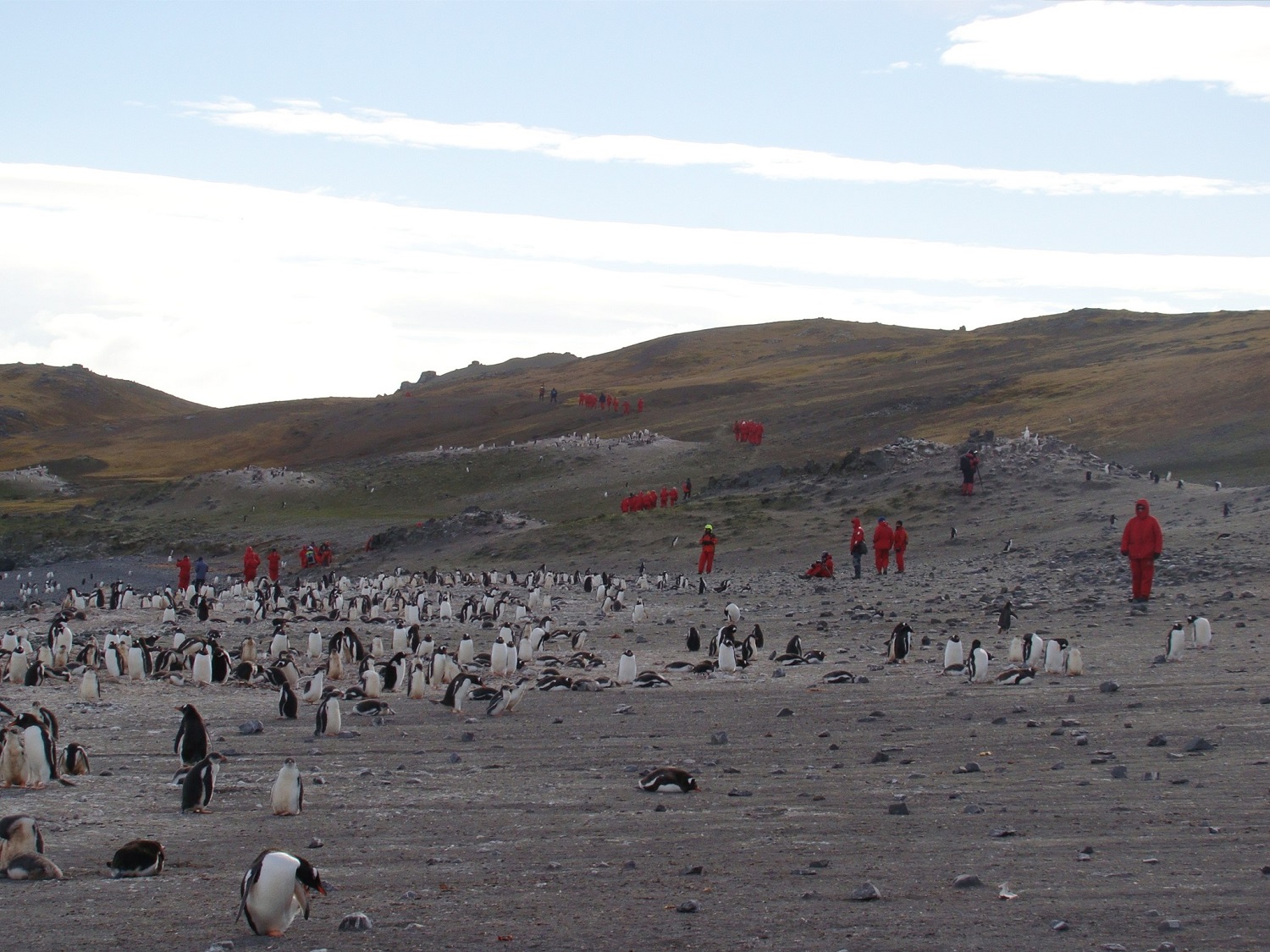
Tourists interacting with a Gentoo penguin (Pygoscelis papua) colony at a popular visitor site
Measures are therefore needed to better protect the environment of Antarctica from tourism , but there are gaps in existing governance frameworks.
All activities in Antarctica are regulated through the Antarctic Treaty System (ATS), which includes The Madrid Protocol. The Protocol provides broad rules for tourism, however day-to-day management is mostly self-regulated by the industry through guidance issued by the International Association of Antarctica Tour Operators (IAATO).
Many researchers and conservation organisations are concerned that self-regulation is no longer sufficient to protect Antarctica’s wildlife and ecosystems from the impacts of tourism.
Why is this important?
The protection of the Antarctic environment is vital to achieve global goals for nature, climate and sustainable development.
However, as the Antarctic tourism industry grows and diversifies, the severity of its negative environmental impacts is likely to increase . If left unchecked, these impacts will be exacerbated by the effects of climate change . For example, reduced sea ice and increased ice-free land areas mean that tourists can visit previously inaccessible places, and a warmer climate will allow the industry to extend the tourist season.
The negative impacts of tourism compound other threats to Antarctica’s wildlife and ecosystems , such as climate change and invasive alien species .
Combined, these threaten the continent’s unique biodiversity, including species such as krill, fish, seals, whales, penguins and other seabirds , as well as putting at risk Antarctica’s ability to help regulate the global climate.
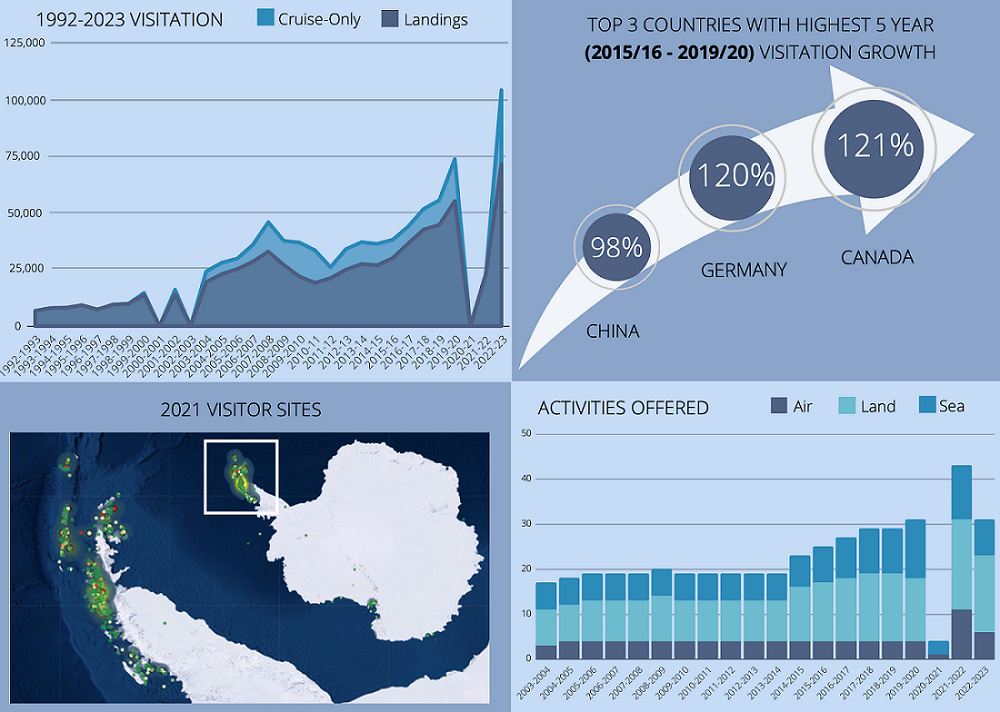
Visitor trends, fastest-growing source markets, distribution of visitor sites and growth in tourism activities
What can be done?
Tourism in Antarctica must be effectively and proactively managed, with decisions based on science and informed by best practice .
Such an approach should consider projections of tourism and climate trends, and will require the cooperation of stakeholders including the tourist industry (IAATO and its members), researchers, conservation organisations and governments (via national Antarctic programmes).
More research is needed to inform the policies and implementation of this management approach. All proposed visitor sites and tourist activities should be evaluated using the precautionary principle . Researchers should explore the ecological impacts of tourist activities at local and regional levels, assess existing guidelines and whether tourism operators comply with them, and identify the gaps in current protections.
It is likely new safeguards will be needed , which could include stronger protections within the Antarctic Treaty System or specifying the appropriate type, amount, location and route of tourism activities in the management plans for all Antarctic protected areas.
Continual monitoring of tourism impacts is essential to assess and refine the effectiveness of new protections. Governments, research funders and the tourism industry should support monitoring programmes and help coordinate research activities.
Researchers should develop indicators that go beyond counting visitor numbers , and reflect wider impacts on Antarctica’s biodiversity, wilderness and ecosystem services.
Efforts should be made to enhance the positive impacts of tourism as a conservation tool . Measures could include incorporating more conservation education into visitors’ schedules, and involving tourists in Antarctic citizen science programmes in which members of the public help gather data for research projects.
Researchers should also evaluate how visiting Antarctica changes tourists’ long-term behaviour.
Where can I get more information?
IUCN WCC 2016 Resolution 032 Achieving representative systems of protected areas in Antarctica and the Southern Ocean
Strategy for IUCN’s Programme and Policy on Antarctic Issues (IUCN, 2009)
A Strategy for Antarctic Conservation (IUCN, 1991)
Tourism and Non-governmental Activities (ATS, 2022)
Proactive Management of Antarctic Tourism: Time for a Fresh Approach. ATCM XLII, IP 26 (ATS, 2019)
Cajiao D, Benayas J, Tejedo P, Leung Y-F. Adaptive Management of Sustainable Tourism in Antarctica: A Rhetoric or Working Progress? Sustainability . 2021; 13(14):7649. doi.org/10.3390/su13147649
Related content

This second edition of The state of protected and conserved areas in Eastern and Southern Africa…
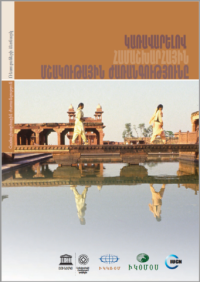
The manual provides guidance for States Parties and all those involved in the care of World…

Sign up for an IUCN newsletter
- Share full article
Advertisement
Supported by
Tourism in Antarctica: Edging Toward the (Risky) Mainstream
Travel to one of the most remote parts of the planet is booming. What does that mean for the environment and visitor safety?

By Paige McClanahan
In January, the Coral Princess, a ship with 2,000 berths and a crew of nearly 900, plowed through the frigid waters off the Antarctic Peninsula, cruising past icebergs, glaciers and mountains clad in snow. The cruise, which had been advertised at less than $4,000 per person, is remarkably cheaper than most Antarctic expeditions, which often charge guests at least three times that amount for the privilege of visiting one of the wildest parts of the planet. Visitors to the region — and the ships that carry them — are growing in number: Antarctica, once accessible only to well-funded explorers, is now edging toward the mainstream.
But managing tourism is a tricky issue in this distant region where no individual government has the power to set the rules, and the challenge is becoming more complex as Antarctica’s popularity grows. During the current austral summer, which runs from roughly November to March, visitor numbers to Antarctica are expected to rise by nearly 40 percent from the previous season. Some observers warn that such rapid growth risks imperiling visitor safety and adding pressure to this fragile region, which is already straining under the effects of climate change, commercial fishing for krill, toothfish and other species, and even scientific research.
Human activity in Antarctica falls under the governance of the Antarctic Treaty system, a model of international cooperation that dates to the Cold War era. But day-to-day management of tourism is regulated by the tour operators themselves, through a voluntary trade association that sets and enforces rules among its members. Observers agree that this system has worked well since it was set up in the 1990s, but some worry that booming tourist numbers could push the old system to a breaking point. They say that the consultative parties to the Antarctic Treaty system — governments like those of the United States, France, New Zealand, Argentina and some two dozen others — must act more quickly to manage tourism, and protect the region’s value as a wilderness.
“The bottom line for us is that there aren’t a lot of hard rules governing tourism. It’s mostly voluntary,” said Claire Christian, executive director of the Antarctic and Southern Ocean Coalition (ASOC), a network of more than 15 conservation groups that serves as an observer to the Antarctic Treaty system. “Right now, there is a lot of good will. But that’s not something you can guarantee.”
A booming industry
Tourism in the Antarctic began with a trickle in the 1950s, but the industry remained exclusive and expensive. Expeditions grew steadily and by the late 1980s, a handful of companies were offering sea- and land-based trips. In 1991, seven private tour operators came together to form the International Association of Antarctica Tour Operators (IAATO). Among other things, the group’s aims were to promote “environmentally safe and responsible travel”; improve collaboration among its members; and create — among the operators’ paying clients — a “corps of ambassadors” who could advocate conservation of the Antarctic region after they returned home from their trips.
Visitor figures soon began to creep up, increasing from roughly 6,700 in the 1992-1993 season to nearly 15,000 by the end of that decade, according to IAATO figures. Apart from a dip after the 2008 financial crisis, numbers have risen steadily ever since. More than 56,000 tourists visited Antarctica during the 2018-2019 season. The figure for the current season is expected to rise to more than 78,500, more than double the total from a decade ago. The vast majority of visitors come by cruise ship, setting sail from ports like Ushuaia in Argentina or Punta Arenas in Chile.
Meanwhile, IAATO has been gaining an average of two to five operators every year, according to Lisa Kelley, IAATO’s head of operations. Its members now include 48 tour operators, as well as five provisional members (Princess Cruises among them) and more than 60 associates — travel agents, marketers and others that work in the industry but don’t run their own tours.
“At the end of the day, we’re all a bunch of competitors,” said Bob Simpson, vice president of expedition cruising at the luxury travel company Abercrombie & Kent and a former chair of IAATO’s executive committee. “But it’s in our best interest to work together and cooperate,” he added, “to ensure this extraordinary place is protected for future generations.”
Mr. Simpson said that IAATO has been “remarkably successful” in promoting sustainable travel to the region, noting that, in his view, the education and experiences that they offer their guests outweigh the negative impact of the carbon emissions associated with the trip.
Abercrombie & Kent and other IAATO members agree to abide by the organization’s bylaws and guidelines, as well as the rules set out by the Antarctic Treaty system. These govern things like the number of passengers allowed ashore during site visits, staff-to-visitor ratios, and the amount of experience required of the crew.
The rules also stipulate that vessels — like the Coral Princess — that carry more than 500 people are not allowed to make landings; they can only “cruise” off the coast. Smaller vessel expeditions — offered by companies such as Abercrombie & Kent, Hurtigruten and Lindblad Expeditions, among others — are allowed to make landings, and their passengers might have the opportunity to disembark with guides to walk, kayak, snowshoe, or even camp or ski onshore.
Membership in IAATO remains voluntary, although all Antarctic tour operators must obtain a permit to travel in Antarctica from one of the parties to the Antarctic Treaty. For now, Ms. Kelley said, every passenger ship operating in the Antarctic is either a member or provisional member of IAATO, apart from some private yachts, defined as vessels carrying 12 or fewer passengers. She is confident that the organization is ready to accommodate the surge in tourist numbers.
“We’ve learned our lesson from the previous two big spurts of growth,” Ms. Kelley said in a recent phone interview. “We’ve really looked at our systems carefully and really worked on trying to make them as robust as we possibly can.”
Safety concerns
Other observers are less confident that rising tourist numbers are sustainable. The risks range from possible damage to sites that tourists visit to the potential growth in non-IAATO tour operators to ensuring visitor safety.
Accidents are rare, but not unheard-of. In November 2007, the MS Explorer, a Liberian-flagged vessel carrying about 100 passengers and 50 crew, cracked its hull on submerged ice, then started to take on water and list severely. Those aboard evacuated to lifeboats around 2:30 a.m., then floated in the cold for more than three hours before another ship, the cruise liner Nordnorge, rescued them. No one was killed or injured, but that was in part because of the weather.
“Within two hours after the passengers and crew were aboard the Nordnorge, the weather conditions deteriorated with gale force winds,” according to the official investigative report into the incident, which was conducted by the Liberian Bureau of Maritime Affairs. “If the Nordnorge’s speed to the scene had been reduced due to rough sea conditions, there may have been fatalities from hypothermia.”
The environment didn’t fare as well. The MS Explorer slipped beneath the waves carrying more than 55,000 gallons of oil, lubricant and petrol; two days later, an oil slick spread over an area of nearly two square miles near the site of the wreck. A Chilean naval ship passed through to try to speed up the dispersal of the fuel, but the report noted that the “oil sheen” was still visible more than a year later.
Ms. Kelley said that measures have been introduced since the Explorer incident, including the International Maritime Organization’s new “ polar code ,” which, she said, imposes “real limits on where and how vessels can operate and how new ships should be built.” Fuel tanks must now be situated away from the vessel’s hull, for example; navigation officers are required to have more experience and environmental rules have been tightened.
But as visitor numbers grow, so, too, does the risk of an accident. And while all tour operators in the Antarctic are currently IAATO members or provisional members, a status that offers them a degree of support, there is no guarantee that companies new to the region will see the value in joining the organization. If they decide to go it alone, there is nothing to stop them.
“There have been incidents, but we have always been quite lucky in the sense that maybe the weather conditions were right or there were other ships around,” said Machiel Lamers, an associate professor at the Environmental Policy Group of Wageningen University in the Netherlands. “Having a couple of thousands of passengers and crew in Antarctic waters is, of course, another thing than having a couple of hundred.”
A fragile environment
Scientists warn that the rise in tourism also increases the risk of disrupting the fragile environment. The introduction of invasive species — nonnative crabs or mussels clinging to the hull of a ship, foreign plant seeds stuck in the lining of a tourist’s parka — remains an important and ever-present threat . There is also evidence that populations of penguins and other wildlife have been disturbed by human activity in some areas. At the popular Hannah Point, there have been two reported instances of elephant seals falling off a cliff because of visitor disturbance. At other sites , historic structures have been marred by graffiti.
The Antarctic Treaty parties have drawn up “ site visitor guidelines ” for 42 of the most popular landing sites; these govern things like where ships are allowed to land, where visitors are allowed to walk, and how many landings are allowed per day. But the IAATO website lists more than 100 landing sites on the Antarctic Peninsula. Those with no guidelines in place may become more popular as tour operators try to avoid the crowds.
Pollution from ships is another concern. Although the International Maritime Organization’s polar code introduced new measures to control pollution, it still allows ships to dump raw sewage into the ocean if they are more than 12 nautical miles, roughly 13.8 miles, away from the nearest ice shelf or “fast ice” — stationary sea ice attached to the continent or grounded icebergs. It also fails to regulate discharges of “graywater,” runoff from ships’ sinks, showers and laundries that has been shown to contain high levels of fecal coliform as well as other pathogens and pollutants. Concerns about pollution are perhaps all the more worrying given the arrival of Princess Cruise Lines, which — alongside its parent company, Carnival Corporation — has been heavily fined for committing serious environmental crimes in other parts of the world.
A spokeswoman for Princess Cruises stressed in an email that the company is “committed to environmental practices that set a high standard for excellence and responsibility to help preserve the marine environment in Antarctica.” Negin Kamali, Princess Cruises’ director of public relations, added that the company meets or exceeds all regulatory requirements for Antarctica.
Fuel pollution, especially carbon emissions — is another concern, although there have been some positive steps. In 2011, the use of heavy fuel oil in the Antarctic was banned under the International Convention for the Prevention of Pollution from Ships (MARPOL). Today, ships in the region generally use less-polluting marine diesel, although some — like the MS Roald Amundsen , run by the Norwegian company Hurtigruten — have gone a step further, supplementing their traditional fuel with battery power. Princess Cruises is currently testing similar technologies, said Ms. Kamali.
In the background, warmer temperatures are making the entire continent more vulnerable to external threats.
“It’s important to understand that all of these impacts — climate change, fishing, tourism — are cumulative,” Cassandra Brooks, an assistant professor in environmental studies at the University of Colorado Boulder, wrote in an email. “Given the sheer carbon footprint of Antarctic tourism, and the rapid growth in the industry, these operations will become increasingly difficult to justify.”
The way forward
Antarctic Treaty parties are aware that tourism growth will require a new approach. But it’s not clear what steps they will take, nor how quickly they will act. And reaching consensus — which is what decision-making within the Antarctic Treaty system requires — can be a slow and arduous process.
In April 2019, the government of the Netherlands hosted an informal meeting to discuss how to manage Antarctic tourism. The participants — including representatives of 17 treaty parties, IAATO and ASOC, the civil society group, as well as other experts — identified “key concerns” related to the predicted growth in ship tourism: pressure on sites where tourists visit, the expansion of tourism to new areas, and the possible rise in tour operators who choose not to join IAATO, among other issues.
The group’s recommendations were presented to the Antarctic Treaty’s Committee for Environmental Protection as well as to the most recent annual meeting of the treaty parties in July. The discussions seemed to go in the right direction, said Ms. Christian, but they are still a long way from implementing major changes.
Stronger regulations could come in many forms, including a prohibition on potentially disruptive activities such as heli-skiing or jet-skiing, both of which are currently allowed; a general strengthening of the Antarctic Treaty system’s existing guidelines for visitors , which already instruct people not to litter, take away souvenirs, or get too close to wildlife, among other things. Parties to the Antarctic Treaty system could also establish protected areas that could be made off limits to tourist vessels, or agree to enact domestic laws to enable authorities to prosecute visitors for Antarctic misbehavior (penguin cuddling, for instance) after they return home.
Or the treaty parties could go even further: They could require all passenger vessels to obtain IAATO membership before being granted a permit, or set a cap on the total number of visitors allowed each season. Most observers agree that both steps would be politically very difficult to enact, mainly because treaty parties have diverging views of what Antarctic tourism should look like.
Tour operators and some academics maintain that tourism in Antarctica is vital because it creates awareness and builds a network of people who will go home to fight for stronger protections in the region. but — as with scientific research, or any human activity in Antarctica — the risks and potential negative impacts of tourism must be weighed against its benefits.
Whatever policy steps might be on the table, self-regulation in the tourism industry is no longer sufficient, said Ms. Brooks, who adds that Antarctica is already straining under its many pressures.
“IAATO is truly amazing in what they have accomplished, but it’s difficult to imagine how they will manage to control this burgeoning industry,” she wrote in an email. “It’s equally difficult to imagine how more than 78,000 people visiting Antarctica as tourists won’t have a negative impact on the region.”
52 PLACES AND MUCH, MUCH MORE Discover the best places to go in 2020, and find more Travel coverage by following us on Twitter and Facebook . And sign up for our Travel Dispatch newsletter : Each week you’ll receive tips on traveling smarter, stories on hot destinations and access to photos from all over the world.
Come Sail Away
Love them or hate them, cruises can provide a unique perspective on travel..
Cruise Ship Surprises: Here are five unexpected features on ships , some of which you hopefully won’t discover on your own.
Icon of the Seas: Our reporter joined thousands of passengers on the inaugural sailing of Royal Caribbean’s Icon of the Seas . The most surprising thing she found? Some actual peace and quiet .
Th ree-Year Cruise, Unraveled: The Life at Sea cruise was supposed to be the ultimate bucket-list experience : 382 port calls over 1,095 days. Here’s why those who signed up are seeking fraud charges instead.
TikTok’s Favorite New ‘Reality Show’: People on social media have turned the unwitting passengers of a nine-month world cruise into “cast members” overnight.
Dipping Their Toes: Younger generations of travelers are venturing onto ships for the first time . Many are saving money.
Cult Cruisers: These devoted cruise fanatics, most of them retirees, have one main goal: to almost never touch dry land .

- Travel Guide
Antarctica Tourism, The Role Of IAATO & Responsible Travel
History of antarctica tourism, the first sightseeing cruise, growth of ecotourism in antarctica, the international association of antarctica tour operators (iaato): managing tourism in antarctica, what modern antarctica tourism looks like, antarctic tourism statistics: how many tourists visit antarctica, responsible travel in antarctica: protecting the integrity of the white continent.
Antarctica stands icy and glistening at the bottom of the planet as a truly special travel destination—and an increasingly popular one. As farflung as the Earth’s landmasses come, it remains a place that comparatively few people have visited firsthand, but each year brings greater and greater numbers of sightseers, keen to experience the last true wilderness and its astonishing scenery and wildlife.
Compared to other corners of the globe, the timeline of Antarctic tourism is pretty darn short. People didn’t even lay eyes on the White Continent until 1820, and needless to say leisure travel wasn’t exactly on the radar in this staggeringly remote, ice-ruled polar realm for many decades afterward. Antarctica long remained a little-seen realm mainly drawing adventurers, whalers, sealers, and—mainly from the early 20th century onward—scientists.
The dawn of true Antarctic tourism came in January of 1966, with the first-ever expedition cruise to the White Continent led by Lars-Eric Lindblad, a Swede who came to the United States in the 1950s and there established a tour company, Lindblad Travel.
As Lindblad’s son Sven told Elite Traveler , Lars-Eric hatched the plan to lead a tour down to the bottom of the world in the early 1960s, around a campfire in the Gobi Desert of Mongolia. Lindblad asked his guests where they’d like him to bring them next, and a woman answered: “Why not Antarctica?”
The inaugural 1966 expedition cruise led by Lindblad— documented on film , by the way—went down on a specially chartered ship of the Argentine Navy, the Lapataia . Three years later, Lindblad began leading cruises on the first vessel purpose-built for Antarctic cruising: the ice-strengthened MV Lindblad , which continued to ferry sightseers into the 21st century. (It sank due to human error in the Bransfield Strait in 2007.)
Lindblad’s expeditions launched the era of sightseeing tours in Antarctica, and by the late 1980s four operators were leading cruises into these polar waters. In 1985, a company began running the first tourism flights to Antarctica, bringing clients to a field camp in the interior for the purposes of mountaineering, skiing, and the like.
Cruising towards the South Pole
In 1991, the parties signed on to the Antarctic Treaty adopted an important addition to that regulatory system: the Protocol on Environmental Protection to the Antarctic Treaty . Fully implemented by 1998, this protocol declared Antarctica a “natural reserve” and laid out a variety of guidelines and requirements for the continued protection of the White Continent’s largely pristine state. Those guidelines and requirements applied to the growing tourism industry as well as all other human activities in the Antarctic.
Prompted by the adoption of the Protocol, seven tour companies active in Antarctica at that time established that same year the International Association of Antarctic Tour Operators (IAATO) , which, per the IAATO website , is “a global, non-profit industry alliance dedicated to safe and responsible private-sector travel to the White Continent.”
Minimizing the impacts of tourism on Antarctica and upholding the tenets of the Antarctic Treaty’s Protocol on Environmental Protection help guide the IAATO’s efforts. These range from ensuring the most rigorous of training for guides and other staff to supporting scientific work (many scientists and staff of Antarctica’s research bases hop rides on tour vessels to reach the White Continent, for example).
Today IAATO comprises better than 100 members representing the following globe-spanning countries:
- Netherlands
- New Zealand
- South Africa
- Switzerland
- United Kingdom (and the British Overseas Territory of the Falkland Islands)
- United States
As of 2019-2020, according to IAATO records, nearly 50 tour operators are active in Antarctica, with a fleet of some 63 vessels making more than 400 voyages to the White Continent that season.
Most tourism to Antarctica takes place by ship, with IAATO-registered sightseeing vessels categorized as traditional expedition ships carrying 12 to 200 passengers and making landfall ( C1 vessels); midsize ships carrying 201-500 and making landfall ( C2 vessels); large cruise ships carrying 500-plus passengers without making landings ( CR vessels); and small sailing or motor yachts ferrying a dozen or fewer passengers ( YA vessels).
The majority of Antarctic sightseeing cruises embark from South America and head for the Antarctic Peninsula, potentially visiting the Falklands, South Georgia, and other islands en route. But some ships proceed deeper into polar waters, crossing the Antarctic Circle and foraying into the Weddell or Ross seas; a relative handful journey along the coast of East Antarctica.
Some Antarctic tourists leaving from South America skip the ship-borne crossing of the Drake Passage and fly to the South Shetland Islands, thereafter joining a cruise to the Antarctic Peninsula. And some operators lead flights into the Antarctic interior for mountain-climbing, visiting the South Pole, and other bucket-list adventures.
Camping in Neko Harbour
The White Continent has grown in popularity as travelers hunger for new, exotic locations and interest in this comparatively untouched wilderness—not least in this era of climate change and heightened concern over humanity’s impact on the biosphere—continues to mount.
The IAATO keeps record of how many tourists go to Antarctica each year. The first tourism season after the organization’s establishment, 1992-1993, saw 6,704 tourists make landings in Antarctica courtesy of 10 tour operators and 59 voyages.
During the aforementioned 2019-2020 season—when the sightseeing fleet had ballooned past 60 vessels and voyages numbered in the hundreds—almost 60,000 tourists made landfall in Antarctica, with another 18,420 cruise-only passengers enjoying the sights from offshore.
There are both positive and negative impacts of tourism in Antarctica, as anywhere. Experiencing the White Continent firsthand—its fluted icebergs, looming ice-shelves, seal colonies, penguin towns, ice-armored summits, whale-plowed leads and bays—inspires vital awareness of how precious, and how vulnerable, this incredible place is. Part of the IAATO’s mission , for example, is using responsible tourism to “create a corps of ambassadors for the continued protection of Antarctica.”
But the chance to see the dreamscape that is Antarctica comes with some heady responsibility. That’s only as it should be, given the White Continent is the last great subaerial wilderness on Earth. Everybody coming here—researchers, tour operators, guides, and tourists—must do their part to lighten their impact on the landscape and seascape and their ecosystems.
Choosing an Antarctic experience via an IAATO outfit is fundamental to responsible ecotourism. The IAATO maintains an excellent collection of online resources focused on visitor guidelines for Antarctica, well worth checking out even if you’re only in the early stages of considering such a trip.
Indeed, there’s plenty you can do before leaving to ensure you’ll be lessening your footprint in the Antarctic as much as possible. That includes selecting environmentally conscientious products such as reusable items, non-plastic packaging, and eco-friendly formulations and fabrics.
It also means taking steps to avoid bringing any unwanted living cargo along with you. After all, exotic (i.e., non-native) species are a major risk to the Antarctic ecosystem—some 200 have already been introduced to this remotest continent, most notably plants such as grasses and sedges and invertebrates such as midges and fruit flies—and it’s all too easy to transport seeds or insects in your clothing and gear. Thoroughly cleaning your belongings before your departure helps lower the chance of spreading such pests to and around the White Continent. While traveling, meanwhile, abide by the cleaning/decontamination protocol established by your operator, and generally stay aware of when you may be picking up organic matter on your clothing or equipment; clean such debris off before moving on to another site.
Penguin family in Port Lockroy
Enjoying Antarctica’s spectacular wildlife responsibly means giving animals an adequate amount of space and doing everything possible to avoid altering their behavior, even minimally. If you flush a seabird or startle a hauled-out seal into the water, you’re forcing these creatures to expend valuable energy, and also very likely boosting stress hormones.
Tour operators are, of course, expected to shoulder much of the burden of navigating respectfully around wildlife: keeping vessels a minimum distance from animals (a contextual judgment), avoiding pursuing or boxing in dolphins and whales, keeping travel lanes amid bird or seal rookeries clear, and so on. But tourists themselves must always bear in mind that their individual actions can definitely disturb animals, and aside from following all instructions from guides, they should be familiar with responsible wildlife-watching guidelines on their own.
Other essential—and hopefully common-sense—practices for lightening your impact on the Antarctic environment include leaving all rocks, egg shells, and other natural objects where they lie; keeping close tabs (and a tight grip) on your belongings to avoid littering; and being sure not to deface or otherwise disturb historical sights and artifacts, not to mention scientific instruments and infrastructure.
You May Also Be Interested In
Antarctica’s greatest mysteries & hidden secrets revealed, the truth about antarctica: common myths & legends debunked, scott’s, shackleton’s & mawson’s huts in antarctica & their amazing contents, top 9 historical places & monuments in antarctica to visit, research stations in antarctica: top 8 antarctic bases, little america in antarctica, admiral richard e. byrd & operation highjump, the antarctic snow cruiser & other lost antarctic vehicles, antarctica’s bay of whales & its place in history, shackleton endurance expedition & voyage of the james caird.
Our travel guides are for informational purposes only. While we aim to provide accurate and up-to-date information, Antarctica Cruises makes no representations as to the accuracy or completeness of any information in our guides or found by following any link on this site.
Antarctica Cruises cannot and will not accept responsibility for any omissions or inaccuracies, or for any consequences arising therefrom, including any losses, injuries, or damages resulting from the display or use of this information.
Ready for the adventure of a lifetime?
Get in touch with us via phone or form today and you’ll be assigned a dedicated Antarctica specialist who’ll be with you every step of the way to help you choose, book and plan the right Antarctica cruise for you. Here’s how it works:
Listen & Match
We’ll carefully listen to your aspirations and curate an impartial shortlist of personalized polar cruise recommendations—and pre- and post-cruise extensions—to match your desired experience.
Reserve & Relax
Next we’ll place a free, no obligation, 24-hour cabin hold on your preferred cruise option whilst we discuss the final details. Book and relax safe in the knowledge you’ll be paying the lowest price guaranteed.
Prepare & Travel
Then we’ll provide you with our expert packing advice, insider travel tips, and more to ensure you are fully prepared for—and maximize your enjoyment of—your once-in-a-lifetime Antarctica expedition.
- With Partner/Friend
- With Family
- As Part Of A Group
- Emperor Penguin
- Photography
- Exploration Heritage
- Antarctic Peninsula
- Antarctic Circle
- Falklands/S. Georgia
- Weddell Sea
- Ross Sea/E. Antarctica
DEAL FLASH: Get 30% Off & An Exclusive $600 Air Credit On The Nov 14 Departure On World Explorer
Ask LP: how can I travel to Antarctica?

Oct 7, 2020 • 3 min read

Antarctica's tourist season starts in November © DreamPictures / Getty Images
The far south of the world may have escaped the pandemic that’s locked down life elsewhere, but that doesn’t mean this summer season is smooth sailing. Antarctica has no cases of COVID-19 – partly due to efforts to keep it that way, and partly reflecting the restrictions placed on other countries. This impacts scientists who make up the temporary residents of the continent and also threatens the Antarctic tourist season, which generally runs from November to March or April.
In a normal year, travelers would converge on Ushuaia (Argentina), Punta Arenas (Chile), and, less frequently, ports in New Zealand and Australia to embark on the long journey south. The shortest route – across the swells and choppy waters of the Drake Passage from South America – takes two to three days to reach the Antarctic Peninsula . Air options like DAP’s overnight trips to King George Island in the South Shetland Islands ($6500 per person from Punta Arenas, Chile) usually gives another way to reach the far south from South America for a more limited time. Services are currently suspended.

There are two big obstacles to getting to Antarctica this year. One is the lack of cruises – most operators have cancelled their schedules for the remainder of the this year and early next year. If cruises can happen at all this season it will be towards the end of the usual period of operation. Hurtigruten has cancelled Antarctica departures until January 2021, but hopes to resume operations then.
The other is the inaccessibility of gateway destinations. At the time of writing there’s no way into Chile , Argentina , New Zealand and Australia for foreign tourists. All these countries have closed their borders to non-nationals since March, and Argentina has recently paused plans to allow international flights back into the country until at least October 11. In all likelihood, this will be longer. Sub-Antarctic destinations have their own entry restrictions. The Falkland Islands (Islas Malvinas) are only accessible for essential travel with reduced air links. In order to reach Antarctica, any departing travelers heading south would need to transit Argentina (or one of the other jumping-off countries) and transfer directly to their cruise ship. As you’d expect there’s no confirmed plan for this at present.

Adding all this up, 2020–21 may be a better time to save for a future Antarctic odyssey. However knock-on demand for 2021–22 is likely to be strong, as capacity is always limited and there is an Antarctic solar eclipse in November next year. That said, specialist travel companies are also keen to encourage booking, and deals for next year are available through experts like Discover the World .
One way for ice-cap enthusiasts to get their fix from Australia is to take a seat on one of the scenic overflights of the continent run by Antarctica Flights . These 12 hour journeys – using a 787 Dreamliner for the first time – depart from various Australian airports from November to March. They don’t touch down and therefore count as a domestic charter flight. Currently there is not a requirement to wear a mask on these flights.
You might also like:
Is it sustainable to visit Antarctica? How to pack for a trip to Antarctica The eternal lure of icebergs: fulfilling a life-long dream of visiting Antarctica
Explore related stories

Jun 30, 2024 • 12 min read
From remote scrubland to towering glaciers, a road trip will bring you to every corner of Patagonia like nothing else. Here are 8 of the best.

Jun 29, 2024 • 8 min read

Jun 29, 2024 • 9 min read

Jun 28, 2024 • 7 min read
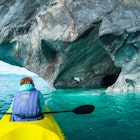
Jun 26, 2024 • 10 min read
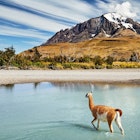
Jun 25, 2024 • 13 min read

Jun 24, 2024 • 11 min read

Jun 21, 2024 • 9 min read

Jun 20, 2024 • 6 min read
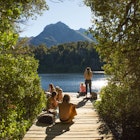
Jun 17, 2024 • 6 min read
- Environment
- Road to Net Zero
- Art & Design
- Film & TV
- Music & On-stage
- Pop Culture
- Fashion & Beauty
- Home & Garden
- Things to do
- Combat Sports
- Horse Racing
- Beyond the Headlines
- Trending Middle East
- Business Extra
- Culture Bites
- Year of Elections
- Pocketful of Dirhams
- Books of My Life
- Iraq: 20 Years On
Will Antarctica be the next victim of overtourism as visitor numbers continue to climb?
Balance between travel and preservation in world’s most remote wilderness is a fragile one.
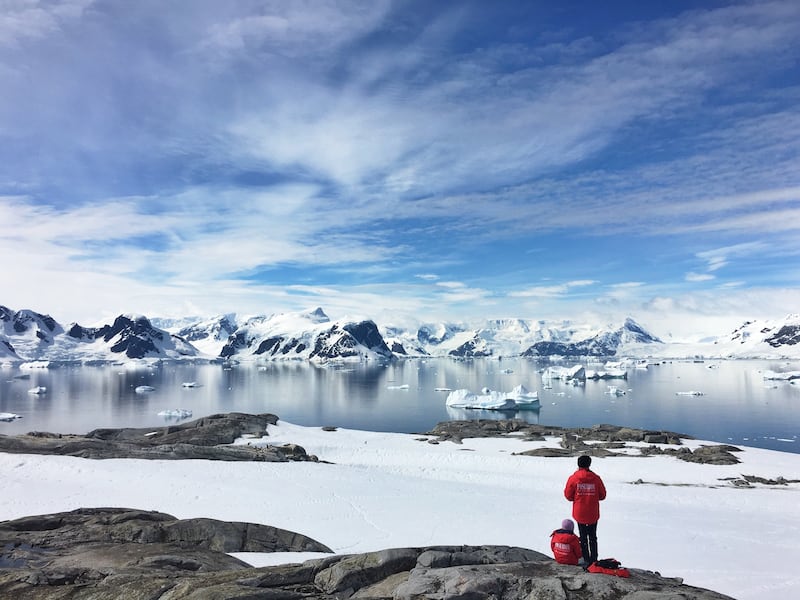
As more travellers flock to Antarctica, the world's most protected wilderness faces an increasing conservation risk. Unsplash / Cassie Matias

Last year, for the first time, more than 100,000 tourists visited Antarctica. That figure is expected to increase in 2024.
It is in stark contrast to visitor numbers during the global pandemic when only two ships and 15 people ventured to the southern wilderness in the name of tourism .
Leslie Hsu, a freelance journalist and award-winning photographer, understands why. She had one of her most memorable holidays in the region.
She recounts a story of camping on the Kerr Point of Ronge Island, where she could hear the iceberg-laden waters of the Errera Channel lapping against the shore.
“I make my way towards the shoreline until I can hear waves striking rocks,” she tells The National . “Turning off my headlamp, I am engulfed in darkness, barely able to see my fingers in front of my face. At first, I feel exposed, vulnerable – unusual for someone who grew up camping, hiking, spelunking, climbing mountains and crossing rivers. Someone who came to Antarctica precisely to be alone with the coldest , driest, windiest, most hostile place on Earth.
View this post on Instagram A post shared by Leslie Hsu Oh | Writer + Photographer + Editor (@lesliehsuoh)
“A series of glaciers calving, one after another like dominoes, ripples towards me. I feel the ground trembling. Water rushes towards me and I cringe, expecting to be swept away into the channel. After things settle down, I sit down on the soft snow. Surprisingly, I don’t feel cold at all, cosy in my wind and water-resistant parka and boots. I doze. I listen. I breathe. Out of the darkness, blacks brighten to greys. There is no sunrise, just a gradual increase in contrast.
“I hear a whale surface for air. Kelp gulls tweet a morning greeting. And just when I start to worry that maybe I shouldn't be sitting out here by myself, I see six Gentoo Penguins take form not a stone’s throw away. They are all sleeping with their necks tucked into their backs, perfectly camouflaged in the austere black and white landscape.”
It's precisely this type of once-in-a-lifetime experience that has so many travellers flocking to Antarctica.
Unique journeys across the White Continent
This polar region is roughly twice the size of Australia and 98 per cent covered in ice. It is the largest wilderness on Earth unaffected by large-scale human activities and, as the only continent without an indigenous population, it is also one of the most protected places on the planet.
Winter in Antarctica is from March until October, and when daylight hours disappear, temperatures plunge to minus 30-60°C and the physically remote destination becomes even more inhospitable. But by autumn, as the country’s unique wildlife begins to emerge from hibernation, so too do the zealous tourists.
Antarctica is also the only continent with no terrestrial mammals, but it does have millions of penguins, thousands of seals and eight different species of whale. The allure of seeing these creatures in the wild is one of the main reasons people keep coming to the remote land.
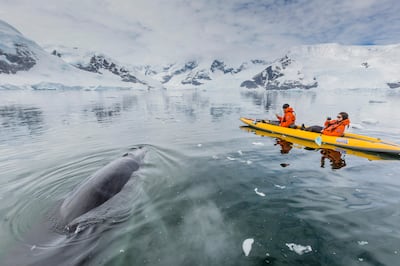
Google data comparing search traffic from 2019 to 2022 showed a 51 per cent rise in interest around Antarctica cruises, and a 47 per cent rise in interest for Arctic cruises. Other trips are on the rise, too. These include luxury travel company Black Tomato’s nine-night Antarctic adventure that sailed to the White Continent at the same time the region witnessed a rare solar phenomenon. Or Elite Expeditions' new voyage that will see travellers conquer the glacial beauty of Antarctica's Vinson Massif.
While the pause in tourism during the pandemic allowed wildlife to thrive, the International Association of Antarctica Tour Operators estimates that 106,000 visitors travelled to the region in the 2022-2023 tourist season, meaning those who work to protect the White Continent and its environment are wary of this increasing interest.
A wilderness that belongs to no nation
Seven countries – New Zealand, Australia, France, Norway, the UK, Chile, and Argentina – have all laid claim to different parts of Antarctica, but the destination is governed by an international partnership to which more than 56 countries have acceded, making it a wilderness that belongs to no nation.
Its tourism board is also unique. In 1991, the International Association of Antarctica Tour Operators (IAATO) was set up not to encourage more visitors, but to regulate the sector and ensure the pristine environment remains so. Since 2009, concerns about the impact of tourism on the environment have been a recurring hot topic at the continent’s annual Antarctic Treaty Consultative Meeting.
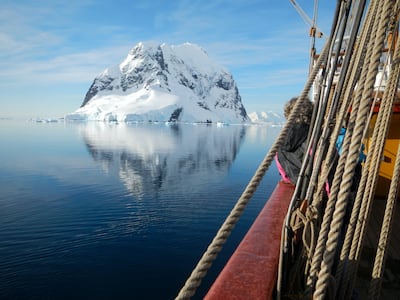
Several measures are already in place. As most visitors venture to the seventh continent via ship, better practices have been adopted to reduce the carbon footprint and environmental impact of any cruises sailing in these waters. There are also restrictions on how many people are allowed ashore, and strict regulations for planned activities, wildlife watching, and pre and post-visit activity reporting.
These rules are carefully followed by Black Tomato on all of its voyages. “We demand the highest standards from our partners, in everything from sustainability to safety, creativity to delivery,” says Tom Marchant, co-founder of the luxury tour operator. “In Antarctica, those standards mean we only work with a small selection of hand-picked IAATO-approved operators, and have seen us advocate light-touch, small-scale experiences where we can be assured that guidelines are being followed.”
In a post-pandemic world, the tourism company sees travellers seeking one-off adventures, something Antarctica is perfectly poised to offer. “A burgeoning trend we’ve seen since the pandemic is a strong pursuit of [what we call] the 'opposite', be it a safari, the wilderness, volcanic ranges or rugged islands – the flip side of big buildings and noisy cars in everyday life,” Marchant explains.
“Now, more than ever, travellers are seeking out the world untainted by crowds and queues. A world more ancient than our own, and with deeper roots. Antarctica is a great example of where dramatic and unfamiliar landscapes offer inimitable encounters that are all about experiencing the unknown. The opposite of our own daily lives.”
Will overtourism be Antarctica's downfall?
But as a destination that has long been sheltered from mass tourism, could this recent spike in traveller interest be the continent’s downfall? Could Antarctica be on track to become overtourism’s next victim, going the way of Mount Everest, with overcrowding and environmental pollution? Or of Italy’s Venice, which constantly struggles with the impact of visitors flocking in from visiting ships?
The IAATO says it is unlikely this will happen, saying the region's strict protection protocols are its saving grace.
“Antarctica is one of the most protected locations – if not the most protected location – on Earth when it comes to managing human activity,” a representative for the organisation tells The National . “All human activity there must be authorised by a competent authority and is subject to an Environmental Impact Assessment before proceeding.
“There is still a misconception that visitors to Antarctica are permitted to explore as they like, picking up souvenirs from the coastline and disturbing wildlife. IAATO’s rigorous rules and guidelines explained and enforced by expert field staff, coupled with robust policies laid out by the Antarctic Treaty, ensures this is not the case.”
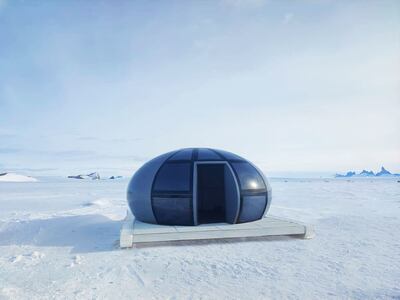
White Desert, an ultra-luxury travel operator that specialises in zero-impact trips to Antarctica, has been a member of IAATO for nearly two decades. “We take just 250 people yearly – a maximum of 12 guests per trip travel to our camps during season, which runs from mid-November until February,” says chief executive and founder Patrick Woodhead.
“We have five key steps in place to minimise our impact, including using sustainable aviation fuel , carbon offsetting, an environmentally conscious supply chain that ensures we use no single-use plastic and responsibility for waste disposal. We also use solar energy to heat our pods and minimise use of fossil fuels. And we support and contribute to both the local scientific community and the Antarctic community.”
It's common for Antarctica operators to use tourism dollars to help fund scientific research that can help the world better understand the White Continent. Viking Cruises, for example, uses both of its Antarctic ships to host scientists, wet labs and detailed research programmes, all funded by holidaymaker’s money. And Ponant uses tourism revenue to offer science expedition grants for studies in the region.
IAATO says contributions like these are “fundamental to achieving research objectives in different fields of knowledge, going from the understanding of polar tourists’ behaviour and learning to the evaluation of environmental changes in places threatened by global warming”.
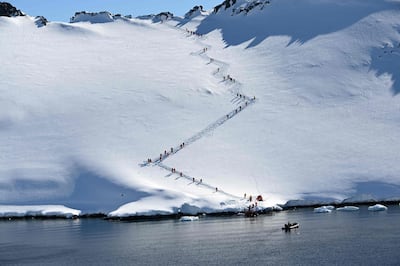
But for the conservation-focused Antarctic and Southern Ocean Coalition, the measures adopted by tour operators may not be enough.
“In the absence of a comprehensive plan for managing tourism and tourist activities, adding new trips, inland activities and off-the-beaten-path excursions in Antarctica is a risky trend,” says the NGO's executive director Claire Christian.
“Ideally, any expansion in the areas that tourists visit or diversification of activities that tourists participate in should only take place as part of a management plan that has fully considered whether these activities are consistent with the environmental protection goals of the Environment Protocol. However, right now, there is no such plan.”
A delicate balance
While the majority of people visiting the region do so on vessels and never step foot on the ice, as more travel companies go out of their way to offer unique journeys that take travellers on land, the risk to the destination increases.
No matter how regulated the industry is, if the tourists snowshoeing through Antarctica’s ice-covered wilderness don’t adhere to the same ethos, damage could be inevitable.
To pre-empt this, IAATO publishes a series of general guidelines that visitors are expected to follow. These include everything from not touching wildlife to responsibly discarding rubbish and being aware of protected areas. However, membership to the association is not compulsory and if there are 106,000 visitors heading to Antarctica in a single season, how realistic is it that every tourist’s actions can be controlled?
Hsu questioned this on her dream trip to Antarctica last year. “Hurginten Expeditions was very careful about marking all the places that travellers were allowed to hike with cones whenever we left the ship, but even though they marked it off, it wasn’t always 100 per cent clear what areas we were supposed to stay away from,” she explains.
“I did wonder if all of these people walking around were affecting the landscape. We also saw many empty research stations as we ventured across the continent and this made me wonder whether these abandoned buildings are environmentally safe.”
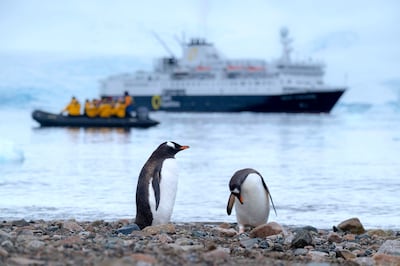
Some tour operators, including White Desert, believe that by offering these life-changing expeditions, they will help “create a community of Antarctic Ambassadors who will share the importance of conserving the planet for future generations”.
Hsu is a living example of this. “The first thing I did when I got home was Google 'Antarctica Ambassadors' to find out more about this collaboration of people who care passionately about Antarctica and protecting its unique landscape. I had never heard of it before and I immediately signed up.”
Despite these initiatives, a question mark hangs over how Antarctica may fare as tourism continues to rise, especially as the Antarctic treaty that preserves the continent will only remain in place until 2048. After that, any treaty party can request a review, which could lead to crucial elements being changed.
“The treaty is up for renewal in 25 years and it’s vital that it’s upheld,” says White Desert founder Woodhead. “The protocol contains a number of tools, including environmental impact assessments and protected areas, that are extremely effective. Parties simply must use them, and it is critical for Antarctica's future.”
It may not yet be on course to rival Mount Everest as one of tourism's nature playgrounds, but as of now the balance of travel and preservation in the world’s most remote wilderness remains as fragile as the ice-covered sheets that surround it.
Checking In
Travel updates and inspiration from the past week

- Search Please fill out this field.
- Manage Your Subscription
- Give a Gift Subscription
- Newsletters
- Sweepstakes
- Travel Tips
How to Visit Antarctica
From how to get there to what to pack, here's what you need to know about visiting Antarctica.
Meena Thiruvengadam is a lifelong traveler and veteran journalist who has visited more than 50 countries across six continents. Her writing has appeared in The Wall Street Journal , Departures , TripSavvy , and other publications.
:max_bytes(150000):strip_icc():format(webp)/Meena-Thiruvengadam-0953f29450f840a786278802ac6a8162.jpeg)
There is at least one place left on earth where you really can disconnect: Antarctica.
There is no mobile phone service. There are no town squares, no restaurants, and no tourist traps. The local "airports" are really just ice or gravel landing strips.
Antarctica is nearly twice the size of Australia and mostly covered with a thick sheet of ice. It's one of the most remote destinations in the world and the trip of a lifetime for many travelers. It's also easier to travel to Antarctica than one might think.
Lars-Eric Lindblad first took a group of 57 visitors to Antarctica in 1966. "At that time it was more or less like accomplishing a moon landing," his son Sven-Olof Lindblad said. "In those days, we were not as prepared as we are now. There were no satellite ice charts. You were not that different navigationally from the early explorers."
Even now it can be hard to really understand Antarctica. It is the coldest and windiest place on earth and, by some measures, the driest. It has no currency of its own. It is a desert with no trees, no bushes, and no permanent residents. More meteorites are found in Antarctica than in any other place in the world.
"Antarctica is about the wildest place you can go on the planet," Lindblad said.
It's also an increasingly popular place to visit. According to the International Association of Antarctica Tour Operators , tourism more than doubled from 2010 to 2020.
"The conversation around climate change has elevated people's interest and created a sense of urgency," Lindblad said.
The Best Times to Go to Antarctica
The Antarctic travel season lasts from November through March, the Antarctic summer. Temperatures are often below freezing at this time of year, especially in the continent's interior, but they can reach as high as 50 degrees Fahrenheit.
The best time for penguin spotting is late December or early January. Wait too long and previously pristine penguin colonies get dirty and smelly, said Nik Horncastle , a regional specialist with Audley Travel. For peak whale watching, try February or March.
Other activities, including snowshoeing, kayaking, skiing, camping, snorkeling, diving, and visits to historic sites from earlier expeditions, can be experienced throughout the season.
How to Get to Antarctica
One of the more common routes to Antarctica is by ship via Ushuaia, a city at the southern tip of Argentina. Several companies, including Hurtigruten Expeditions , Quark Expeditions , and Lindblad's namesake Lindblad Expeditions , specialize in Antarctic and polar cruising, offering journeys that range in length from just over a week to a full month and beyond.
On board, expect to mingle with scientists, naturalists, historians, and underwater specialists. "The onboard experience is a conversation around where you are and what does this place mean," Lindblad said. Internet service via satellite is available but comes with a hefty price tag.
Antarctica is one place where smaller boats offer a big advantage. "We don't recommend a boat over 200 people," Horncastle said. "Big boats can only stop at a few sites."
That said, if you want to visit Antarctica on a traditional cruise line, many major carriers can get you there — often on vessels that adhere to that fewer-than-200-guests rule of thumb. Some more affordable lines, like Norwegian and Royal Caribbean , stick to "cruise-only" itineraries, which sail along the Antarctic coast (and offer great views in the process) but don't allow disembarkation on the continent. A number of others, though, from Viking Cruises and Disney Cruise Line to Ponant and Silversea , take passengers right into the Antarctic interior, thanks to on-shore excursions and ships with icebreaker capabilities.
Booking an Antarctica Expedition
Expect to spend between $6,000 and $50,000 to visit Antarctica, depending on the length of the trip and the level of luxury you seek.
"It's an expensive trip," Horncastle said — but there are options if you're traveling on a budget.
Intrepid Travel and G Adventures both specialize in affordable trips to Antarctica, and neither requires single supplements for solo travelers. If you don't feel the need to set foot on the continent, you can also opt for a sightseeing flight. These flights, which cut costs by flying over Antarctica without stopping there, are available from most major cities in Australia at prices that start around $1,200 per person.
To both fly over and step onto the continent, Antarctica21 combines a two-hour flight from Chile with cruises that passengers can board in Antarctica. While this option doesn't give visitors the chance to cruise the famous Drake Passage, it does save time and minimize the risk of seasickness.
"The Drake Passage is a crossing full of unpredictable conditions," said Antarctica21's Francesco Contini. "When the crossing is rough, passengers tend to be not very comfortable."
Packing List for Antarctica
- Knee-high waterproof boots
- Waterproof pants
- A warm parka
- Waterproof gloves
- Warm base layers
- Extra socks
- A tight-fitting beanie
- A warm scarf
- A camera and lenses
- Seasickness medication
Related Articles
share this!
January 5, 2023
This article has been reviewed according to Science X's editorial process and policies . Editors have highlighted the following attributes while ensuring the content's credibility:
fact-checked
trusted source
written by researcher(s)
Antarctic tourism: Should we worry about damage to the ice and ecosystems?
by Elizabeth Leane, Anne Hardy, Can Seng Ooi, Carolyn Philpott, Hanne E.F. Nielsen and Katie Marx, The Conversation
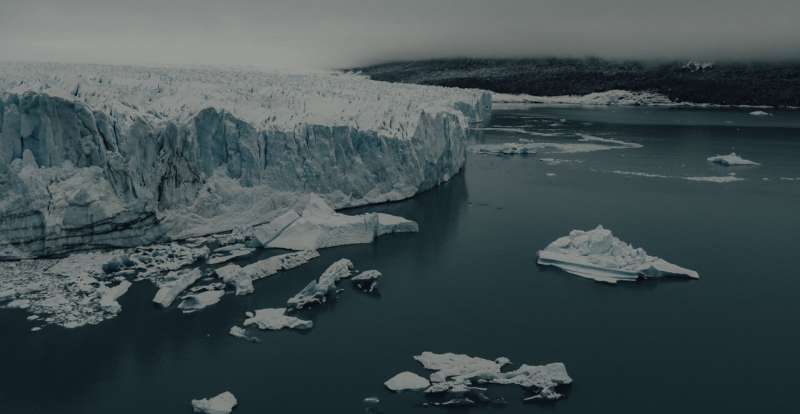
As the summer sun finally arrives for people in the Southern Hemisphere, more than 100,000 tourists will head for the ice. Travelling on one of more than 50 cruise ships, they will brave the two-day trip across the notoriously rough Drake Passage below Patagonia, destined for the polar continent of Antarctica.
During the COVID summer of 2020-21, just 15 tourists on two yachts visited Antarctica. But now, tourism is back—and bigger than ever. This season's visitor numbers are up more than 40% over the largest pre-pandemic year .
So are all those tourists going to damage what is often considered the last untouched wilderness on the planet? Yes and no. The industry is well run. Tourists often return with a new appreciation for wild places. They spend a surprisingly short amount of time actually on the continent or its islands.
But as tourism grows, so will environmental impacts such as black carbon from cruise ship funnels. Tourists can carry in microbes, seed and other invasive species on their boots and clothes—a problem that will only worsen as ice melt creates new patches of bare earth. And cruise ships are hardly emissions misers.
How did Antarctic tourism go mainstream?
In the 1950s, the first tourists hitched rides on Chilean and Argentinian naval vessels heading south to resupply research bases on the South Shetland Islands. From the late 1960s, dedicated icebreaker expedition ships were venturing even further south. In the early 1990s, as ex-Soviet icebreakers became available, the industry began to expand—about a dozen companies offered trips at that time. By the turn of this century, the ice continent was receiving more than 10,000 annual visitors: Antarctic tourism had gone mainstream.
What does it look like today?
Most Antarctic tourists travel on small "expedition-style" vessels, usually heading for the relatively accessible Antarctic Peninsula. Once there, they can take a zodiac boat ride for a closer look at wildlife and icebergs or shore excursions to visit penguin or seal colonies. Visitors can kayak, paddle-board and take the polar plunge—a necessarily brief dip into subzero waters.
For most tourists, accommodation, food and other services are provided aboard ship. Over a third of all visitors never stand on the continent.
Those who do set foot on Antarctica normally make brief visits, rather than taking overnight stays.
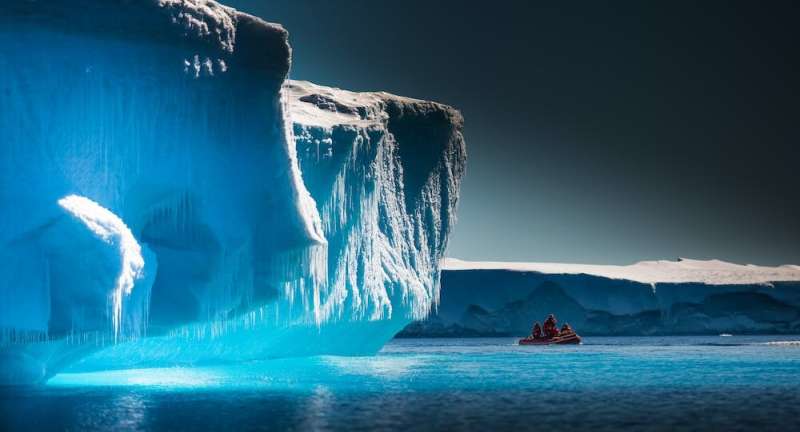
For more intrepid tourists, a few operators offer overland journeys into the continent's interior, making use of temporary seasonal camp sites. There are no permanent hotels, and Antarctic Treaty nations recently adopted a resolution against permanent tourist facilities.
As tourists come in increasing numbers, some operators have moved to offer ever more adventurous options such as mountaineering, heli-skiing, underwater trips in submersibles and scuba diving.
Is Antarctic tourism sustainable?
As Antarctic tourism booms, some advocacy organisations have warned the impact may be unsustainable. For instance, the Antarctic and Southern Ocean Coalition argues cruise tourism could put increased pressure on an environment already under significant strain from climate change.
In areas visited most by tourists, the snow has a higher concentration of black carbon from ship exhaust, which soaks up more heat and leads to snow melt. Ship traffic also risks carrying hitchhiking invasive species into the Southern Ocean's vulnerable marine ecosystems.
That's to say nothing of greenhouse gas emissions. Because of the continent's remoteness, tourists visiting Antarctica have a higher per capita carbon footprint than other cruise-ship travellers.
Of course, these impacts aren't limited to tourism. Scientific expeditions come with similar environmental costs—and while there are far fewer of them, scientists and support personnel spend far more time on the continent.
Antarctic tourism isn't going away—so we have to plan for the future
Are sustainable cruises an oxymoron? Many believe so .
Through its sheer size, the cruise industry has created mass tourism in new places and overtourism in others, generating unacceptable levels of crowding, disrupting the lives of residents, repurposing local cultures for "exotic" performances, damaging the environment and adding to emissions from fossil fuels.
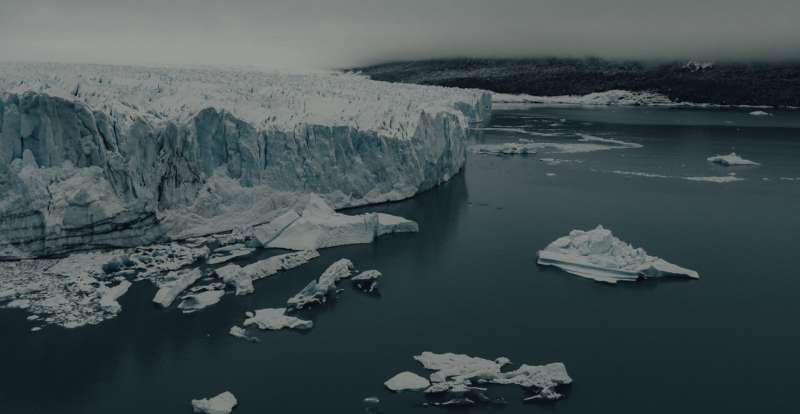
In Antarctica, crowding, environmental impact and emissions are the most pressing issues. While 100,000 tourists a year is tiny by global tourism standards—Paris had almost 20 million in 2019—visits are concentrated in highly sensitive ecological areas for only a few months per year. There are no residents to disturb (other than local wildlife), but by the same token, there's no host community to protest if visitor numbers get too high.
Even so, strong protections are in place. In accordance with the Antarctic Treaty System—the set of international agreements signed by countries with an Antarctic presence or an interest—tourism operators based in those nations have to apply for permits and follow stringent environmental regulations .
To avoid introducing new species, tourists have to follow rules such as disinfecting their boots and vacuuming their pockets before setting foot on the ice, and keeping a set distance from wildlife.
Almost all Antarctic cruise owners belong to the International Association of Antarctica Tour Operators, the peak body that manages Antarctic tourism.
For the first time this year, operators have to report their overall fuel consumption as part of IAATO's efforts to make the industry more climate-friendly. Some operators are now using hybrid vessels that can run partly on electric propulsion for short periods, reducing carbon dioxide emissions.
Returning from the ice: the ambassador effect
Famed travel writer Pico Iyer recently wrote of his experience in the deep south of the world. The visit, he said, "awakens you to the environmental concerns of the world … you go home with important questions for your conscience as well as radiant memories".
Iyer isn't alone. This response is widespread, known in the industry as Antarctic ambassadorship . As you'd expect, this is strongly promoted by tourism operators as a positive.
Is it real? That's contentious. Studies on links between polar travel and pro-environmental behaviour have yielded mixed results . We are working with two operators to examine the Antarctic tourist experience and consider what factors might feed into a long-lasting ambassador effect.
If you're one of the tourists going to Antarctica this summer, enjoy the experience—but go with care. Be aware that no trip south comes without environmental cost and use this knowledge to make clear-eyed decisions about your activities both in Antarctica and once you're safely back home.
Provided by The Conversation
Explore further
Feedback to editors

The Milky Way's eROSITA bubbles are large and distant
Jun 29, 2024

Saturday Citations: Armadillos are everywhere; Neanderthals still surprising anthropologists; kids are egalitarian

NASA astronauts will stay at the space station longer for more troubleshooting of Boeing capsule

The beginnings of fashion: Paleolithic eyed needles and the evolution of dress
Jun 28, 2024

Analysis of NASA InSight data suggests Mars hit by meteoroids more often than thought

New computational microscopy technique provides more direct route to crisp images

A harmless asteroid will whiz past Earth Saturday. Here's how to spot it

Tiny bright objects discovered at dawn of universe baffle scientists

New method for generating monochromatic light in storage rings

Soft, stretchy electrode simulates touch sensations using electrical signals
Relevant physicsforums posts, the secrets of prof. verschure's rosetta stones.
Jun 27, 2024
Should We Be Planting More Trees?
Jun 18, 2024
Earthquake precursors associated with the Turkey earthquakes
Jun 13, 2024
Is it possible to transform an electric thunderstorm into an EMP storm?
Jun 4, 2024
Jacchia Atmospheric Model
Jun 3, 2024
Iceland warming up again - quakes swarming
More from Earth Sciences
Related Stories

Some see Antarctica as 'last chance' destination. For others, it's a backdrop
Apr 12, 2022

Antarctica tourism regulation urgent for environment: summit
May 17, 2018

The COVID-19 pandemic impacted research and tourism, even in Antarctica
Apr 14, 2022

Antarctica's emperor penguins could be extinct by 2100. And other species may follow if we don't act
Dec 23, 2022

Each Antarctic tourist effectively melts 83 metric tons of snow
Feb 23, 2022

In Antarctica, tourists swim among penguins
Nov 29, 2019
Recommended for you

Drowning in waste: Pollution hotspots in aquatic environments

Climate change to shift tropical rains northward, suggests computer modeling

Antarctic ice shelves hold twice as much meltwater as previously thought

Clean Water Act leaves about 55% of water flowing out of rivers vulnerable to pollution, study suggests

Dunes decoded: A comprehensive and precise mapping for coastal conservation

Some Chinese cities have outsourced on others' efforts to cut carbon emissions
Let us know if there is a problem with our content.
Use this form if you have come across a typo, inaccuracy or would like to send an edit request for the content on this page. For general inquiries, please use our contact form . For general feedback, use the public comments section below (please adhere to guidelines ).
Please select the most appropriate category to facilitate processing of your request
Thank you for taking time to provide your feedback to the editors.
Your feedback is important to us. However, we do not guarantee individual replies due to the high volume of messages.

E-mail the story
Your email address is used only to let the recipient know who sent the email. Neither your address nor the recipient's address will be used for any other purpose. The information you enter will appear in your e-mail message and is not retained by Phys.org in any form.
Newsletter sign up
Get weekly and/or daily updates delivered to your inbox. You can unsubscribe at any time and we'll never share your details to third parties.
More information Privacy policy
Donate and enjoy an ad-free experience
We keep our content available to everyone. Consider supporting Science X's mission by getting a premium account.
E-mail newsletter

Should I Go To Antarctica? Best Time To Visit and Travel Guide
Going on an expedition to Antarctica is one of the Top 100 Travel Adventures in the world. View the list and follow our mission to complete them.
A place explored by so few, Antarctica is the coolest destination on Earth, both literally and figuratively. It is remote, untouched and unusual, leaving people to often wonder, can you go to Antarctica? Then, more importantly, why on earth would you even want to?
As for why, well that depends on the person and their reason for traveling in the first place. Going to Antarctica is a world’s Top 100 Travel Adventure and a bucket list trip for any world traveler.
That said, our reasons to visit Antarctica are endless and are a surprise to many people. Its remoteness, epic adventures, chilling history, curious wildlife and endless opportunities for photography are just a few reasons we had Antarctica on our bucket list.
Don’t leave home without: Lonely Planet Antarctica (Travel Guide)
Can You Go to Antarctica?
Table of Contents
Of course, you can travel to Antarctica! It is one of the most common questions people ask when they are thinking about visiting Antarctica.
Taking a trip to Antarctica is like going to the last great wilderness which is one of the many reasons it has called out to us for years.
Truth be told, people have been traveling to Antarctica for tourism since the 1960s. It is possible to visit the white continent from South America or New Zealand and travel is typically by ship – like we did! – although some companies are now offering charter flights.
Visiting by Expedition Ship

Traveling by expedition ship is the most popular option for travelers to visit Antarctica. Expedition ships sail to Antarctica from South America or New Zealand .
Most Antarctic Peninsula trips last 8 to 25 days from South America and departs from Argentina or Chile. From South America the expedition cruise ship season to Antarctica runs from November to March depending on weather and ice conditions.
We explored Antarctica with Quark Expeditions on their MV Sea Adventurer ship that departed from Ushuaia, Argentina and explored the South Shetland Islands and Antarctica Peninsula.
Quark Expeditions is the leader in polar adventures and being on their expedition to Antarctica we experienced it first-hand. From unique adventures and the experienced staff to the well-designed expedition ship.
The team on the ship not only provided a good trip but went above and beyond to provide the ultimate experience in Antarctica.
Flying to Antarctica
In the 1970s, sightseeing flights by airliners started from Australia and New Zealand and in the latest years, some companies have started to offer tourist flights to Antarctica.
Now, we’re not talking about commercial flights that you can book online. We’re talking about private charters that are available by a couple of the polar providers.
Quark Expeditions offers a flight to the Antarctic Peninsula flying over the Drake Passage allowing you to experience Antarctica the fastest and most direct way.
Their Antarctic Express option allows you to fly from Punta Arenas, Chile to Antarctica return but the flights are highly weather dependent. Anyone with their heart set on flying to Antarctica should have a very flexible travel schedule.
Going to Antarctica – 16 Reasons Why You Should
Now that we have shown you that yes, it is possible to travel to Antarctica, it’s time to tell you why you would want to. It is a legit question and one that we are beyond excited to share with you.
1. It’s the Most Remote Destination in the World

Antarctica is one of the most remote destinations in the world to travel to. To get there you have to cross the Drake Passage, the most notorious and rough seas on the planet. Upon completing that, you arrive at a large ice-covered landmass that cannot support a long-term civilian.
There is no indigenous population, besides the local penguins, and no evidence to suggest anyone has ever stepped foot there until the last few centuries.
Its remoteness is just one of the many reasons to go to Antarctica. When was the last time you traveled to a location that was that remote?
It is not like most places where you can just book a flight and end up there in a few hours, at least for the normal person (Quark Expeditions recently started offering charter flights to Antarctica).
No more than nearly 60,000 people will be going to Antarctica this year, in terms of tourism that’s small when Paris will have around 17.44 million visitors in one year.
Due to the remoteness, only 1% of the world’s population will ever visit Antarctica.
2. Antarctica is the 7th Continent

To us, a trip to Antarctica was so much more than just the 7th continent but for many people visiting the Antarctic, it is a huge milestone. Marking off the seventh continent is the top reason that most people choose to visit Antarctica.
A visit to Antarctica for many travelers is the last checkmark in an impressive travel resume. For young and old this is a huge travel accomplishment, that so few travelers in the world have done.
Some have been waiting a lifetime to visit Antarctica and some have even traveled there because their loved ones wanted to visit and never made it.
Nothing else in this world compares to setting foot on the seventh continent. Call it a bucket list check or call it what you want, it’s one of the most popular reasons to visit Antarctica.
3. For the Adventure

Joining an expedition that is going to Antarctica is a true adventure. Sailing from Ushuaia in South America leaves you to follow the path of the classic explorers that made their way to Antarctica before you.
Crossing the Drake Passage is an adventure in itself. Some days it can be whipping like a washing machine and others it can be nice and calm.
On the calm days, you will be able to view Albatross, with their more than six-foot wingspan, soaring off the stern of the ship.
Upon reaching Antarctica, there are endless adventure activities to do including kayaking , hiking, camping and the polar plunge.
All while just being present in one of the most untouched destinations in the world. That’s what is so magical about a trip to Antarctica, it is a true adventure.
4. For the Expedition (every trip is different)

I travel to experience things, I try to let the adventures evolve and I don’t like canned adventures.
This is why I absolutely love expedition travel. On an Antarctic expedition, I can tell you that you’ll be traveling from point A to Antarctica and then back to point A. What happens in between, well that’s the magic of it.
Every expedition is different. Weather conditions control where you go and what you can do when you’re there. Wildlife sightings and encounters control how long you may stay and how you may view them.
The appetite for adventure is what drives an expedition ship and that’s a reason why we love them. They are all about exploring and letting the adventure evolve.
5. For the History

Antarctica has a rich history of explorers and countries trying to put their footprint on it. Many have failed and in doing so they have left amazing historical sites throughout Antarctica.
While some are nothing more than ruins, left neglected to the harsh weather and others have been preserved for generations to see them.
Explore the whaling and research ruins of Whalers Bay on Deception Island.
Discover the history of Port Lockroy that was originally used for whaling, then as a military base, followed by a research station and now a historic site with a museum. It even has a post office where tourists can mail postcards from Antarctica.
When you’re not seeing it with your own eyes, you’re listening to it through the telling of the expedition leaders who share the stories of the people that have traveled the same route as you.
6. For the Photography

It does not matter if you are a hobbyist photographer with a smartphone or a professional with a kitted out DSLR, the Antarctic presents the opportunity of a lifetime for photography.
Truth be told, there’s really not a bad shot to be had while on an expedition in Antarctica.
The place is hands down a photographer’s dream destination. It offers unique wildlife and amazing landscapes, the seventh continent will give you a chance to take some of the best pictures you have ever taken.
A way to show people about this magical destination and to remember your trip for a lifetime.
7. For the Wildlife

If you love wildlife, you’re going to love Antarctica. Everything is as curious about you as you are about them. On our Quark Expedition cruise to Antarctica, we had endless wildlife experiences that we’ll remember for a lifetime.
Due to the abundance of krill in the icy waters, whales migrate to the end of the earth to feed. The sheer volume of whales is a spectacle you won’t see elsewhere and there’s nothing quite like witnessing humpback whales jumping out of the water next to your zodiac.
Or maybe you’re fascinated with penguins, a species that is only found in the Southern hemisphere. The largest concentration of this interesting bird is found in the most remote place on earth.
You can witness them swimming, playing, hunting, breeding, nesting and fledging on an expedition.
Of course, it’s not all about the penguins and whales, you’ll also be treated to a large variety of special birds, including albatross, and several species of seal.
You will have an intimate look into the lives of these animals and how they survive, it is not an experience that can be replicated anywhere else.
8. For Science

Another popular reason to visit Antarctica is from a scientific perspective. Antarctica is one of the most untouched locations in the world thus making it a prime destination for those studying climate change, paleontology (plants & fossils) and is also a top spot for astronomers to study the sky.
These scientific studies are not just done by scientists. Going to Antarctica with Quark expeditions, we were offered several opportunities to help researchers with their studies with hands-on options for the guests, like identifying whales, to studying clouds for NASA.
When you take an expedition to Antarctica, you are indirectly supporting scientific research in the area.
Most companies operating in Antarctica support researches by providing transportation to and from the continent and by dropping provisions when they are in the area.
9. For Education

Part of what makes a trip to Antarctica so great is the educational element involved. You might be wary of those long sea days to cross the Drake Passage, but never fear, the expedition staff is on hand to teach you all things Antarctica.
These are not those boring lessons that you had to sit through in school, instead, these are exciting presentations by professionals who live and breathe Antarctica and work as part of the expedition staff.
They are the historians, geologists, biologists, ornithologists, naturalists, artists, musicians, doctors, and photographers that you will share your experience with.
Since they are part of the expedition, they are not just on the ship but also onshore with you pointing out things and educating you while you are exploring Antarctica.
This is what makes your experiences so magical. You’re going to see a lot more and you’re going to learn about what you are looking at.
10. For the Snow

I know what you’re thinking, why on earth would someone go to Antarctica to experience snow? There are much cheaper places travelers can go to embrace snow around the world. But it’s not the same, not even close.
There were people on our ship that had never ever experienced snow. Some old, some young and they thought, why not experience it for the first time in an epic location like Antarctica. Unfortunately for them, future snow experiences will be hindered.
Even as someone who grew up in a place where it snows, a lot, it was exciting to wake up after a long night sailing and heading outside to find all the ship decks and railings covered in a layer of snow. There really is no other adventure buildup like that.
I can’t express the feeling you get when you’re hiking on the continent, completely surrounded by penguins, and it starts to snow. Big, beautiful, pure flakes of snow from the sky.
11. For the Big Ice

The first time you spot an iceberg after leaving the tip of South America is a moment you remember the rest of your life.
Ours came in the morning after two days of sailing and it was a massive, unreal tabular iceberg. It was our first connection to Antarctica.
Now, we’ve seen ice before, even big ice during our trip to Greenland , but seeing Antarctic ice is special. It is literally the oldest, purest ice on earth and it is massive in size too.
It is the best place in the world to see every kind of ice you can imagine. Big ice, small ice, icebergs, bergy bits, brash ice, solid ice, glacial ice and, of course, the world’s largest ice sheet.
12. To See it Before it’s Gone or Changes Too Much

Antarctica’s ecosystem is fragile, this is no secret. Did you know the polar environments are hypersensitive to change and are one of the first areas of our planet to show change?
This leaves intrepid travelers wondering how much longer we have left to see this special place.
Let’s be honest, it will not be gone overnight but Antarctica is changing significantly. It is one of the most rapidly warming regions of the world and the changing ecosystem not only affects the ice but the entire balance of the continent and surrounding waters.
Even in a short amount of time visiting Antarctica, your eyes will open to the changes that are happening. You’ll experience a realization that we need to do something now to protect it for future generations.
Going to Antarctica will transform you from a basic tourist to an ambassador for the polar regions.
13. For the Epic Landscapes

There is literally nowhere else on earth like Antarctica and our visit ripped down the stereotypes of what we imagined a visit would be like.
Yes, there were huge jagged ice walls that meet the sea, glaciers, and ice but we were treated to an array of landscapes that you just can’t predict.
We experienced amazing landscapes that looked otherworldly, including black sand beaches, steaming beaches, a massive caldera, towering volcanoes, and enormous snow-covered mountains.
Adding texture was a surprising array of black, gray, red, tan, gradients of blue, dustings of green and many shades of white. Not exactly what you’d expect, is it?
14. To Experience Real Cold

I know what you’re thinking, this is another one of those top reasons to visit Antarctica that is not going to be on my list.
Let me tell you, you might not ‘think’ it’s a good reason to go to Antarctica but it is on the tip of everyone’s mind when they think of Antarctica (extreme cold).
Don’t get me wrong, it is cold but not as cold as you think. When you’re going to Antarctica it will be summer in the Southern hemisphere. As long as you’re dressed for the weather, you will not be cold.
The fresh Antarctic air will definitely catch your attention as you breathe but you will be surprised at how quickly you will adjust to the cold temperatures.
You will embrace the cold by enjoying the hot tub or taking the polar plunge (we did!). Embrace the Antarctic chill, it will probably be one of the best parts of your trip to Antarctica.
15. No Ports of Call

While we spent 6 days in Antarctica, we only saw two other ships in passing. Otherwise, it was just us and Antarctica’s pure nature. There’s literally nothing down there and I feel that’s part of the magic of Antarctica.
No scrambling at ports of call and being funneled to gift shops. No malls, no shopping, and no hotels. A trip to Antarctica has none of that and many travelers love that.
16. Fellow Travelers

I love people on expedition ships. They are unlike other travelers you will meet on your travels. The mix of people is crazy and their past adventures are amazing.
From America’s adventure travel couple marking off the world’s top travel adventures to someone who grew up in a native village in the Arctic, all of our travel paths are interesting.
One thing we all have in common is the love for adventure. Expedition travelers are true adventure lovers who don’t care what they look like, what their coffee tastes like or how long it takes to get to a location. Adventure is in their DNA and it’s about the journey.
Being able to share it with people that share our passion for adventure and lust for world exploration is special. Best of all, we are the types who are not simply list checkers.
We love meeting people that share our passions and it was so fun to talk about what comes after Antarctica.
Have We Convinced You?

I hope our reasons to visit Antarctica has fueled you to actually go out and explore this amazing continent. We could go on for days with endless reasons to visit Antarctica.
There is truly no other trip in the world like going to Antarctica and it will not disappoint. It will be a trip of a lifetime and there will be an endless amount of experiences that will be unlike anywhere else in the world.
Our trip to Antarctica was in partnership with Quark Expeditions , however all opinions are 100% mine, as always.
More on Antarctica:
- 34 Antarctica Cruise Tips You Must Know Before You Go
- How to Visit Antarctica Responsibly: Antarctica Tourism Deep Dive
- 26 UNREAL Things to Do in Antarctica
- Best Time to Visit Antarctica: MONTH by MONTH Breakdown
- Crossing the Drake Passage: What It’s Really Like
- Deception Island: A different side of Antarctica
- Animals in Antarctica You Can See During a Visit
- 121 Epic Antarctica Facts
- Climate Change Awareness from Travel: How to Talk About It
- Ultimate Cruise Packing List (Cruise Essentials for Any Destination!)
Did you like this post? Share it!
Travel planning resources, about david stock.
I have always been an outdoorsman so becoming an adventure traveler was just the next natural step. I love nature, I love to get off the beaten path and I like to explore. I enjoy scuba diving and cars. And yes, Lina and I have a naked dog.
Leave a Comment Cancel reply


Antarctic Tourism – Frequently Asked Questions
How Antarctic tourism began
How did tourism in Antarctica begin?
Tourism to Antarctic coastal areas began in the late 1950s with Chile and Argentina carrying a few hundred fare-paying passengers to the South Shetland Islands. The first expedition to Antarctica with travellers was in 1966 and was lead by Lars Eric Lindblad. The modern expedition cruise industry was born shortly after, in 1969, when Lindblad built the first expedition ship MS Explorer. Since 1970 tourist expeditions have regularly ventured to Antarctica every year.
Is tourism to the Antarctic regulated?
All human activities in Antarctica are regulated by the Antarctic Treaty and its associated measures, including the Protocol on Environmental Protection to the Antarctic Treaty.
The industry is largely managed by the International Association of Antarctica Tour Operators (IAATO), which was founded in 1991 by seven private tour operators involved in Antarctic tourism. It is now an organization made up of more than 100 member companies that aims to advocate and promote the practice of safe and environmentally responsible private-sector travel to the Antarctic.
How many tourist ships operate in Antarctica?
In 2016/2017, a total of 65 vessels are registered with IAATO for travel to Antarctica.
These range in size and capacity:
- C1 = Traditional expedition ships that carry 13-200 passengers and are making landings (33 vessels)
- C2 = Mid-size vessels that carry 201-500 passengers and are making landings (four vessels)
- CR = – Vessels that carry more than 500 passengers and do not make landings (cruise only, six vessels).
- YA = Sailing or motor yachts that carry 12 or fewer passengers (22 vessels).
How many tourists visit Antarctica each year?
Tourism has grown from a few hundred at the beginning of the tourist industry in the 1950s to a total of 38,478 visitors in 2015-2016. It is expected to increase in line with worldwide trends, but is strong correlated with global economic activity. The majority (>75%) of visitors experience Antarctica on ships making landings on the Peninsula. Most of these depart from ports in South America, but some (approx. 6%) fly to the South Shetland Islands where they immediately board a ship for onward excursions. Around 1% of visitors fly in to the Antarctic interior each year. Check the IAATO website for current tourism statistics and trends.
Which part of Antarctica do tourists visit?
Antarctic visits generally concentrate on ice-free coastal zones over the five-month period from November to March. Most vessels sail to the Antarctic Peninsula region although some itineraries include South Georgia and the Falkland Islands. A small number of tourist expedition ships visit the Weddell Sea, the Ross Sea region and East Antarctica, as well as many of the other sub-Antarctic islands (eg Snares Islands and Macquarie Island). Private expeditions also visit inland sites, including Mt Vinson (Antarctica’s highest mountain) and the geographic South Pole.
What tourist activities are involved?
Activities include sightseeing ship-based cruises, visits to operational scientific stations and historical huts, small boat cruising, visits to wildlife sites and other wilderness sites, hiking, kayaking, mountaineering, camping and scuba-diving. The majority are ship or yacht based and a small proportion land-based in temporary field camps.
How are landings managed?
Visits from ship or yacht based tourism ashore are generally of short duration lasting approximately 1-3 hours and of moderate intensity with a maximum of 100 passengers excluding expedition staff. Depending on the site visited and time of year, there can be between 1-3 landings per day using inflatable crafts or, rarely, helicopters to transfer visitors. Field Staff supervise all shore visits with a ratio of one member of staff for every 10-20 tourists. Staff usually has past Antarctic experience (IAATO requires 75% of the field team to have previous Antarctic experience) and occupations can range from: ornithologists, marine biologists, general biologists,
geologists, glaciologists, historians, and naturalists.
All tourists are obliged to comply with the Antarctic Treaty, Environmental Protocol and adhere to the Guidance For Visitors to the Antarctic (Recommendation XVII – 1):
****Note this is not the complete version of 18-1
1. Protect Antarctic wildlife
- Do not disturb wildlife either at sea or on land
- Do not feed or touch animals or photograph in a way that will disturb
- Do not damage plants
- Keep noise to the minimum
- Do not bring non-native species to Antarctica
2. Respect protected areas
- Be aware of the locations of protected areas
- Respect the restrictions that apply to these sites
- Do not damage, destroy or remove artefacts from Historic sites or monuments
3. Respect scientific research
- Obtain permission before visiting Antarctic science stations
- Do not interfere in any way with scientific equipment, study sites or field camps
- Know your capabilities and act with safety in mind
- Keep a safe distance from all wildlife
- Do not stray from the group
- Do not walk onto glaciers or large snowfields unless properly trained
5. Keep Antarctica pristine
- Do not litter
- Do not deface or graffiti rocks and buildings
- Do not remove artefacts as souvenirs. This includes: rocks, bones, fossils and contents of buildings
IAATO Members also operate with codes of conduct that limit approach distances and behaviour in the vicinity of wildlife aggregations. In addition, the Antarctic Treaty Consultative Parties have adopted a series of Site Guidelines for Visitors for the most visited sites in Antarctica.
Can tourists visit BAS stations in Antarctica and South Georgia?
BAS welcomes a small number of visits to its stations from IAATO affiliated companies during the Antarctic summer. Small groups are given a guided tour of the facilities, where they have the opportunity to learn about the world-class science undertaken by BAS, and the logistics that support it.
Maximum number of visits to BAS stations:
- Rothera: up to two tour ships per year
- Signy: up to four tour ship visits per year
- Halley: visits are considered on a case-by-case basis
- Bird Island (South Georgia): visitors are not allowed to Bird Island due to its status as a Site of Special Scientific Interest
- King Edward Point (South Georgia): visits to the fisheries research station at King Edward Point require the prior permission of the Government of South Georgia and the South Sandwich Islands (GSGSSI)
Thank you for visiting nature.com. You are using a browser version with limited support for CSS. To obtain the best experience, we recommend you use a more up to date browser (or turn off compatibility mode in Internet Explorer). In the meantime, to ensure continued support, we are displaying the site without styles and JavaScript.
- View all journals
- Explore content
- About the journal
- Sign up for alerts
- 25 June 2024
Regulate surging tourism in Antarctic, treaty partners say
- Sahana Ghosh
You can also search for this author in PubMed Google Scholar
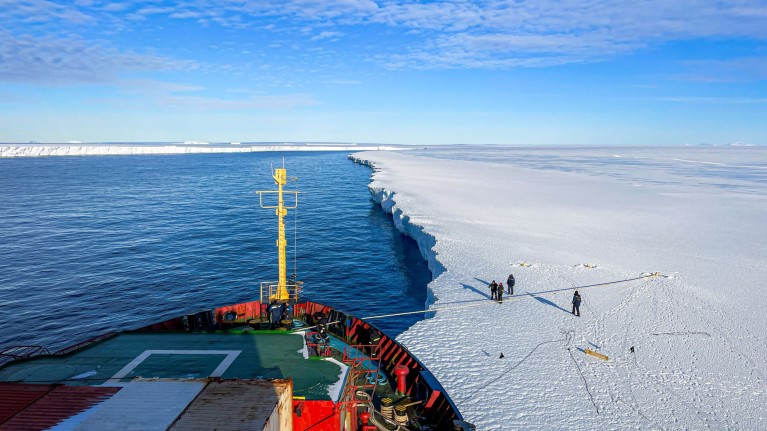
Antarctic sea ice cover hit record lows in 2017, 2022, and 2023. Credit: NCPOR
Amid geopolitical shifts and decreasing sea ice 1 , parties to the Antarctic Treaty are moving to regulate tourism on the continent.
The 46th Antarctic Treaty Consultative Meeting (ATCM) in Kerala in May 2024 focused attention on responsible tourism to preserve the icy continent’s ecology. The International Union for Conservation of Nature warns that existing regulations, like the Madrid Protocol of the Antarctic Treaty System, fail to protect against tourism impacts, including site damage, travel route disruptions, and wildlife disturbances.
A management plan for tourism in the region is urgently needed as parties to the treaty worry about environmental and biosecurity implications, says Thamban Meloth, Director at the Goa-based National Centre for Polar and Ocean Research (NCPOR).
A record 122,072 people visited Antarctica in the 2023-2024 austral season, reports the International Association of Antarctica Tour Operators. Most ships depart from South America to the Antarctic Peninsula, with peak tourist time coinciding with penguin breeding season. Adventure activities such as skiing, snowboarding, ice walking, snorkeling, and scuba diving are steadily increasing in Antarctica, a continent with no native human inhabitants. “Developing this legally binding framework is complex due to Antarctica's unique status as a global commons. It will require consensus within the treaty system, taking several years to mature,” says Meloth.
Tourism in Antarctica began in the 1950s, raising concerns about its potential to disrupt scientific research 2 . This led to the first Antarctic tourism resolution in 1966 by the ATCM, urging member states to withhold permission to visit Antarctic stations without assurances of treaty compliance.
Tourism in Antarctica surged with the MS Explorer in 1969 and regular flights from Argentina a year later. Over the next two decades, mineral exploration and sovereignty issues overshadowed tourism concerns, which nonetheless expanded. In the 1990s, tourism regained attention.
In a 2007 Delhi meeting, India advocated for responsible tourism realising that it cannot be stopped. “There’s good scope for Antarctic tourism from India, with Goa as a gateway. But we must have a multilateral legally binding agreement,” says Rasik Ravindra, a former NCPOR director and former vice-president of the Scientific Committee on Antarctic Research.
India's two operational research stations, Maitri and Bharti, along with the now-abandoned Dakshin Gangotri, a designated historical site under the ATS, could attract Indian travelers. India recently announced plans to commission Maitri’s successor by 2029. Ravindra emphasized that well-planned tourism could educate the public about environmental changes in Antarctica, garnering support for its protection. Recent research 3 indicates that Antarctic sea-ice decline impacts the summer monsoon more than Arctic ice loss, highlighting record lows in 2017, 2022, and 2023, and underscoring the importance of Antarctic research for India.
Geopolitical tensions, particularly the ongoing Russia-Ukraine conflict, have driven up scientific costs by 30%, due to disruptions in supply chains and energy. Indian Antarctic expeditions, typically budgeted at 95-100 crores annually, now hover at 125-130 crores, says Meloth, reflecting increased complexities despite the Antarctic Treaty’s protective measures.
To manage costs, countries like India rely on collaborative logistics, often with nations like Russia, known for robust Antarctic assets. "We must match contributions in cash or kind (logistics) to uphold this support," emphasizes Ravindra, stressing the need for strategic financial preparedness amid rising scientific expense.
doi: https://doi.org/10.1038/d44151-024-00097-5
Purich, A. et al. Commun Earth Environ 4, 314 (2023).
Article Google Scholar
Ravindra, R. Should India Encourage Tourism in Antarctica? (2018).
Google Scholar
Chandra, V. & Sandeep, S. Clim Dyn (2024).
Download references
Reprints and permissions
PostDoc Researcher, Magnetic Recording Materials Group, National Institute for Materials Science
Starting date would be after January 2025, but it is negotiable.
Tsukuba, Japan (JP)
National Institute for Materials Science
Tenure-Track/Tenured Faculty Positions
Tenure-Track/Tenured Faculty Positions in the fields of energy and resources.
Suzhou, Jiangsu, China
School of Sustainable Energy and Resources at Nanjing University
Postdoctoral Associate- Statistical Genetics
Houston, Texas (US)
Baylor College of Medicine (BCM)
Senior Research Associate (Single Cell/Transcriptomics Senior Bioinformatician)
Metabolic Research Laboratories at the Clinical School, University of Cambridge are recruiting 3 senior bioinformatician specialists to create a dynam
Cambridge, Cambridgeshire (GB)
University of Cambridge
Cancer Biology Postdoctoral Fellow
Tampa, Florida
Moffitt Cancer Center
Sign up for the Nature Briefing newsletter — what matters in science, free to your inbox daily.
Quick links
- Explore articles by subject
- Guide to authors
- Editorial policies
Should tourists be banned from Antarctica?
- Published 12 January 2015
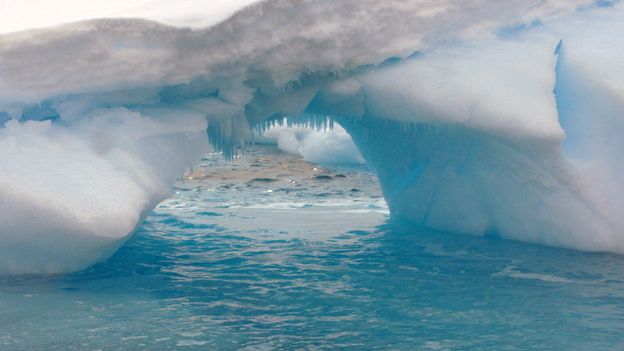
This season around 37,000 tourists are expected to visit Antarctica - home to about 20 million pairs of breeding penguins. But is it ethically acceptable to go on holiday to such a pristine environment?
Enfolded in two glacial arms the bay before us sparkles ultramarine, the water flecked with ice-lilies and dotted with bits of floating icebergs.
A sheer cliff towers dark above us, flanked by snow slopes as pure white as the glistening fronts of the little Adelie penguins whose spectacled eyes peer curiously around as they waddle and toboggan about their business just a few feet away.
This is Brown Bluff on the Antarctic Peninsula and togged up in layer upon layer of fleece, topped with vivid red wetskins I am all too aware that this is not my habitat.
Which begs the question: Should I be here? Am I, just by setting foot on this extraordinary continent, disturbing a pristine environment and polluting the last great wilderness on earth?
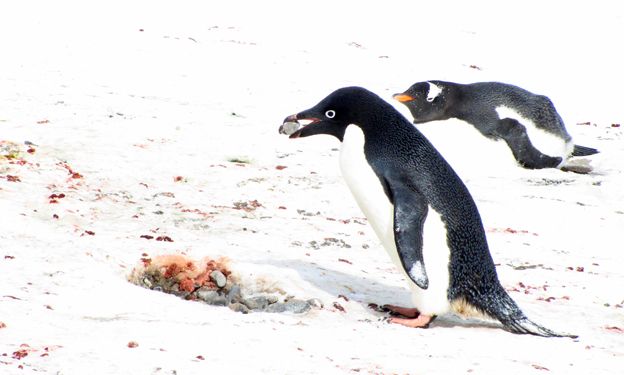
All visitors leave a footprint, admits my tour leader, Boris Wise of One Ocean Expeditions, and we all tend to go to the same places - the accessible coastline - which is also where the penguins and seals go to breed.
Nonetheless, he argues, carefully controlled tourism is not just OK but useful.
Without a native population of its own, Antarctica needs advocates and tourism creates a global constituency of people ready to support - and indeed fund - its preservation.
Not everyone is convinced the benefits outweigh the risks but most are pragmatic.
"It is better to have a certain level of responsible tourism than for it to go under the radar," says Jane Rumble, Head of Polar Regions at the British Foreign Office.
This season 37,000 tourists are expected in Antarctica, although 10,000 will never go ashore.
About half the tourist ships are, like ours, flagged to Antarctic Treaty countries making them legally bound by the treaty's environmental standards.
The other half are worryingly outside this regulation but most are part of the International Maritime Organisation which is just introducing a stricter polar code, and at present all the companies regularly bringing tourists here are members of the International Association of Antarctic Tour Operators (IAATO) which works closely with the Antarctic Treaty System.
The Antarctic Treaty
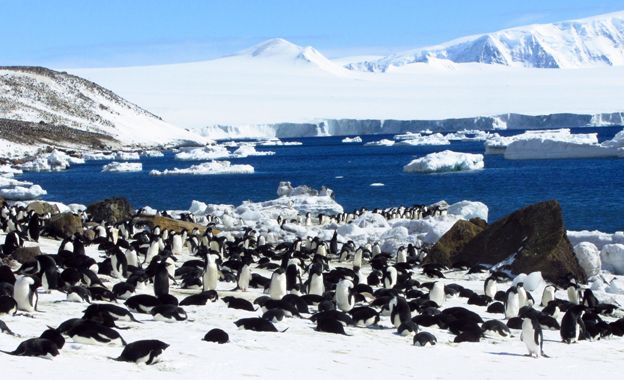
The original treaty was signed in 1961
Aims to demilitarise Antarctica and establish it as a nuclear-free zone
Designed to foster international scientific co-operation and set aside disputes over territorial sovereignty
Original signatories: Argentina, Australia, Belgium, Chile, France, Japan, New Zealand, Norway, Soviet Union, South Africa, UK and US
Another 34 countries have signed it since, including China
Source: British Antarctic Survey , external
As our ship crosses 60 degrees south into Antarctica we are given a mandatory briefing before gathering in the ship's mud room for a "vacuum party".
As a portable amp sets the rhythm with the music of aptly-named bands, Passenger and The Black Seeds, we biosecure ourselves, hoovering our clothes and kit and disinfecting our boots to ensure we introduce no alien species to Antarctica.
Does this really work, I wonder? Apparently it does. Non-native species have been accidentally introduced to the region but not, as far as anyone knows, by tourists.
In fact, research suggest that scientific programmes may have much more environmental impact than tourism.
Scientists, of course, argue that they also bring more benefit, including increasing understanding of how crucially changes in the Antarctic link to changes in the global environment.
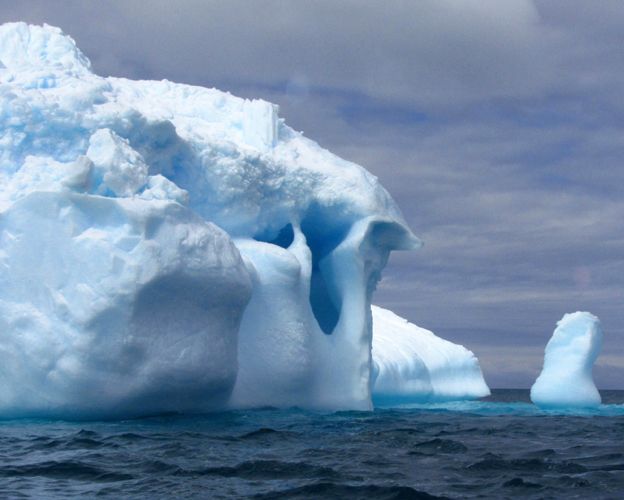
Our ship never docks. We anchor and go ashore by biosecured dinghy.
There is no eating or smoking on land and we are instructed to take nothing away except photographs and leave nothing behind, not even a bit of yellow snow.
"So don't drink too much at breakfast," grins Boris.
We are told not to get any nearer than 5m from Antarctic wildlife.
But nobody told the penguins and, although we never touch, we have delightfully close encounters, especially with the confident little red-beaked gentoos.
One passenger is allowed to get as close as he likes. He is Phil McDowell, marine biologist and penguin counter from the independent research organisation Oceanites, who is hitching a lift on our ship to monitor the penguin colonies we visit.
There have been several studies comparing regularly visited colonies with those rarely in touch with humankind.
The results are strikingly inconclusive showing more-visited colonies variously doing worse, the same and even better.
Gentoos are thriving, McDowell tells me, increasing in both number and range.
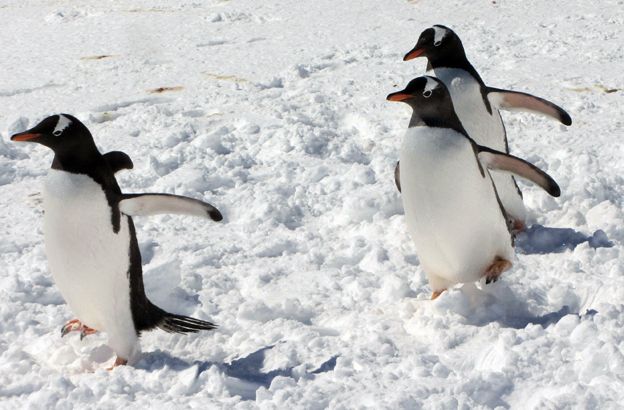
Adelies, and the little helmeted chinstrap penguins, however, are in decline.
The Antarctic Peninsula has warmed by an average of 3C in the last 60 years, and winds have shifted, changing the pattern of the sea ice.
It is global warming that is changing the penguins' fortunes, McDowell suggests, not tourism.
There are concerns for the future however. Tourist numbers look set to rise and membership of IAATO is voluntary.
Tourist ships are starting to offer activities like kayaking, mountaineering and diving which are potentially more invasive than simply looking.
The impact isn't clear and more monitoring is certainly needed.
Back in London, enjoying my photos of ethereal icescapes and brilliantly comic penguins, I wonder again whether I should feel guilty for having been in Antarctica?
"No," says polar expert Jane Rumble, "just do what you can to preserve it."
How to listen to From Our Own Correspondent , external :
BBC Radio 4: Saturdays at 11:30
Listen online or download the podcast .
BBC World Service: At weekends - see World Service programme schedule .
Subscribe to the BBC News Magazine's email newsletter to get articles sent to your inbox.
Related Internet Links

How to be a responsible traveller in Antarctica
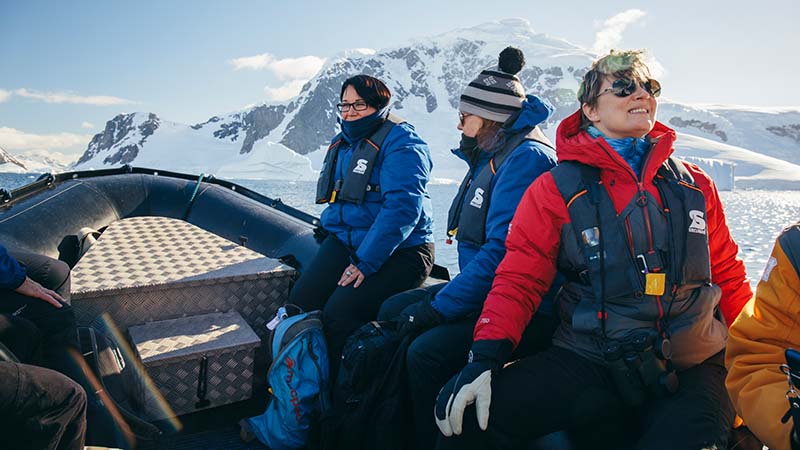
You might think the highest, driest, coldest and most remote continent in the world would be immune to over-tourism. But Antarctic visitor numbers are on the rise (up 17% to 51,000 people in 2018). This is both good and bad news, and understanding why is a big part of being a responsible Antarctic traveller.
There are certain environmentalists that would say the best way to protect Antarctica is not to travel there at all. That, simply by visiting, you’re spoiling the very ‘unspoiledness’ that makes Antarctica special. It’s not a view we subscribe to. But there are certain things you can do to limit your impact and protect the polar environment.
Here’s our guide to being a responsible Antarctic traveller.
To go or not to go?
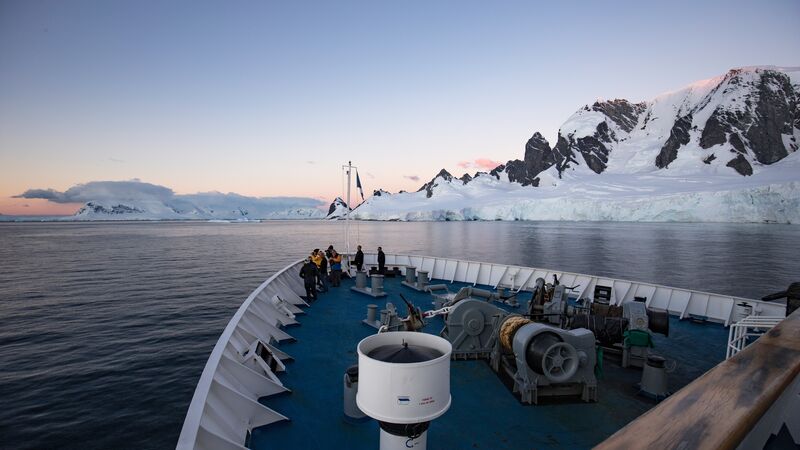
Let’s address the elephant in the room: should you go at all? That’s a decision everyone has to make on their own, and we’re not here to sway you either way. Some conservationists argue that greenhouse gases created by flying to Ushuaia and sailing to the peninsula are the very things threatening the Antarctic ice sheet. And that’s true. Of course, that’s true of any flight, and any journey, anywhere in the world. And there are steps you can take to limit that impact, like flying with an airline that offers carbon offset programs .
The counterargument, which many polar scientists make, is that Antarctica has a unique capacity to change and educate people about the environment. Almost a mystical force. Turning average travellers into passionate advocates against climate change. “You want people to go away as ambassadors, and a lot of them do,” says marine scientist Charlotte Caffrey. “A lot of these voyages are life-changing. We’ve had people go home and change their car to electric, or even change their profession.”
Ultimately, it’s your call. We’ve always believed in the power of travel to educate and inspire people, so we’ll keep leading Antarctic expeditions . But that doesn’t mean we’re not always looking for new ways to offset our impact (you can read more about Intrepid’s carbon policy here ).
CHECK OUT INTREPID’S RANGE OF ANTARCTIC EXPEDITIONS HERE
Limiting the impact
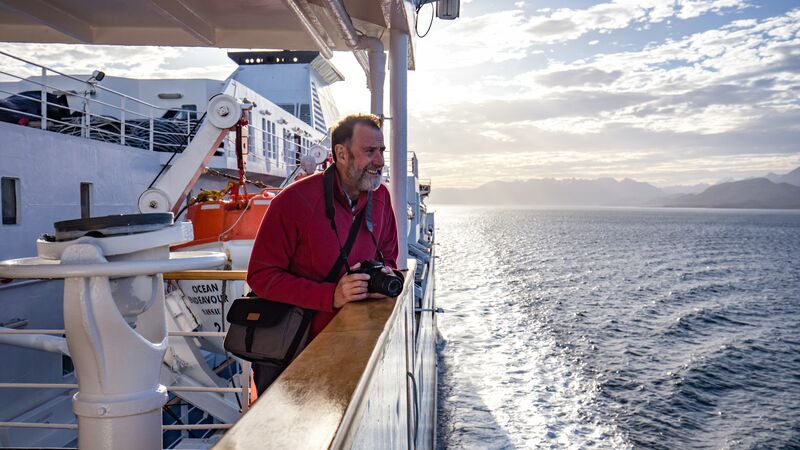
Antarctica is probably the only place on Earth where responsible travel isn’t just advised – it’s compulsory. Here’s how it works: tourism is currently concentrated in 2% of the Antarctic (the Antarctic Peninsula) and runs for five months of the year. About 50,000 people visit each year, and around 10,000 of those never set foot on land. Tourism in Antarctica is overseen by the International Association of Antarctic Tour Operators (IAATO), which was created in 1991. They work alongside the Antarctic treaty to register tour operators and maintain strict environmental standards (we’re registered through our Antarctic partner, Chimu ).
You’ll learn more about these standards on your trip, but it’s good to know that tourism in Antarctica, while growing rapidly, it still controlled: operators cannot land more than 100 people on the ice at any one time and there are only 60-odd vessels registered to bring tourists to Antarctica.
RELATED: POLAR POINTERS: ALL YOUR ANTARCTICA QUESTIONS, ANSWERED
Travel tips for responsible travel in Antarctica
Your Antarctic trip leaders will run through all the rules for safe and responsible travel (they take these things very seriously), but here’s some basic info to get you started:
1. Wildlife
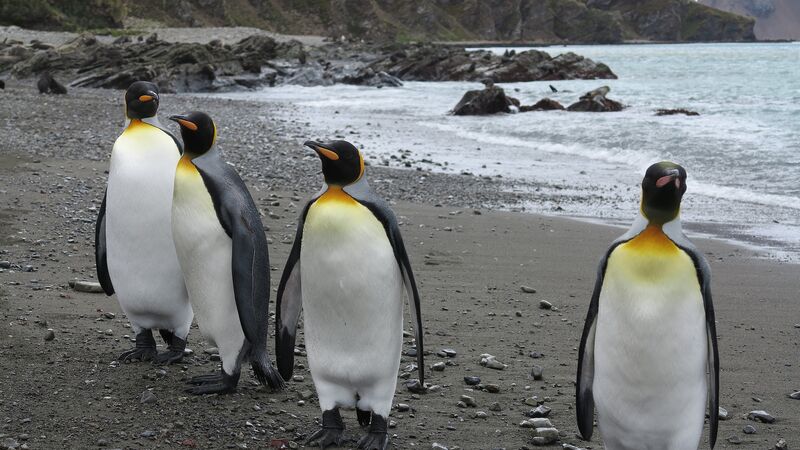
As a general rule, try to stay at least five metres (15 feet) away from any birds, seals or other wildlife. Keep noise down when you’re on the ice, and watch your positioning as a group – don’t surround the animals or cut off their access to the sea. Touching or feeding Antarctic wildlife is strictly prohibited. Of course, the animals themselves don’t know these rules, and they can get inquisitive. That’s fine – if a penguin waddles up, you don’t have to run screaming the other way. Just back up a little and give it some space. Here’s a more comprehensive wildlife guide .
2. Decontamination
Antarctica is pristine – perhaps the only environment on Earth that exists in perfect isolation – and tour operators are obliged to keep it that way. Foreign contaminates like seeds, plants, soil or bacteria are a massive threat to the ecosystem. That’s why you’ll be given special boots for all shore excursions. These get decontaminated after every visit, and you won’t be allowed on the ice without them. Check out some decontamination tips here .
RELATED: WHAT TO PACK FOR A TRIP TO ANTARCTICA
3. Leave nothing behind
It probably goes without saying, but don’t leave anything behind on the ice, and certainly no rubbish. Don’t engrave anything on the rocks or take anything back with you, as tempting as an Antarctic souvenir might be – that includes rocks, eggs, egg shells, fossils, or even man-made items. Also, be careful of the plants. Some rocks on the Antarctic Peninsula are covered in delicate moss and lichen that can take years to grow back – so watch where you step.
RELATED: WHY ANTARCTICA IS AN AMAZING DESTINATION FOR SOLO ADVENTURERS
4. Photography
Flash photography isn’t allowed around the animals (it might spook them), so keep that in mind. Otherwise you’re free to take as many pictures as you like. Just remember the animal guidelines above – most Antarctic travellers will advise investing in a good long focus lens. You can zoom right in on the animals, while staying safely out of their way. Here’s a good Antarctic photography guide , if you need more specific tips.
5. Research
The best thing you can do to help Antarctica? Do your research. Only travel with member of the International Association of Antarctic Tour Operators (you can search the member directory here ). Read up on the IAATO’s visitor guidelines . Learn how to wash your boots properly. Read articles on Antarctic tourism and be aware of the issues. Donate to the Scott Polar Research Institute. Most of all, become an Antarctic ambassador – use this trip to change your day-to-day routine and educate others about the polar environment. That’s the real power of being an Antarctic traveller.
Find out more about our expeditions in Antarctica, explore here .
Feeling inspired?
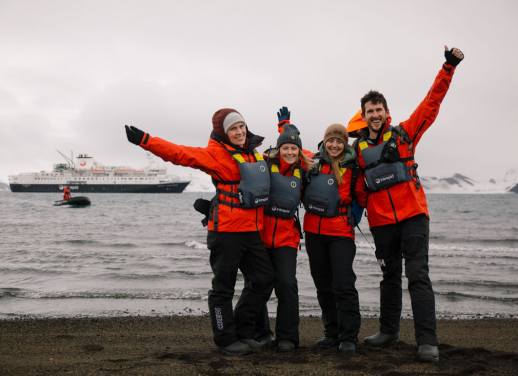
James Shackell
I was born in 1987 and aged from there. I like the sound of pop-rocks and dislike the sound of styrofoam. The length of my forearm is approximately the same as the length of my shin. My favourite Beatle is Ringo. I believe that junk food tastes so good because it’s bad for you and that your parents did the best job they knew how to do. If Johnny Cash wrote a song about my travels it would be called ‘I’ve been to several places but still have many other destinations on my to-do list, man’. Sometimes I have trouble finishing sen
You might also like
All aboard the rail renaissance: 7 reasons to..., explore these 7 tea rituals from around the..., why travellers are choosing the galapagos off-season, tips and hacks for train travel in europe, why train travel is the one experience you..., everything you need to know about a night..., mind your manners: dining etiquette around the world, 5 places to escape the crowds in italy..., is australia safe everything you need to know, 10 fun facts you might not know about..., 12 facts you probably don’t know about guatemala.
Should tourism be allowed in Antarctica?

The popularity of Antarctica as a tourist destination has dramatically increased since the early 90’s, from only about 1.000 people in 1990 to almost 45.000 people in 2016. More than ever, this raises an important question for all travelers that are thinking of making the crossing to the icy continent: should tourism be allowed in Antarctica?
Tourism in general has grown massively since 1990, and in recent years there has been a trend of visiting remote areas in the world. Add to this the fact that people have more disposable income than they used to and the ease of researching destinations and booking tickets online , and you can imagine the cause of this large increase in Antarctic tourists.

Number of tourists visiting Antarctica over time. Source: BBC

“Landed” means those who set foot on the continent or an island in Antarctica whether they arrived by ship or air, such tourists typically spend 6-30 days in Antarctica. Total number of tourists in 2015 / 2016 season: 39.037
How can you visit Antarctica responsively?
Before I embarked on my own trip in 2011, traveling to Antarctica sounded like a mission impossible that was only reserved for the rich and famous, or scientific researchers and explorers. I learned that this is actually true for 99% of the Antarctican continent, but that it is very much possible to set foot on the outer-worldly landscapes of this continent in the Antarctican peninsula , roughly underneath the southern tip of Argentina . Even without an imminent death by frost. Furthermore, it’s even possible to travel to Antarctica without a lifetime of saving , as long as you stick within the seasons and book your trip last-minute with a company that has a high priority for responsible travel.
Guidelines for visiting Antarctica
It’s good to keep to the visitor guidelines for visiting Antarctica in mind. This list of pointers has been adopted as part of the 2011 Antarctican treaty . Your guides will tell you this over and over again and will make sure that you respect them, but its good to have a quick glance over them before you plan your trip:
- Don’t litter on or outside of the boat
- No smoking while on land
- If you have to use the bathroom while you’re on the land, you will be transported back to the boat
- Don’t feed or touch wildlife, simply observe from a distance
- Of course the travel agents and boat personnel have plenty of rules themselves they have to obey in order to operate their tours.

A new-born penguin chick on Antarctica
The big picture: environmental impact
Of course an increasing number of tourists arriving in Antarctica every year has an increased impact on its environment . A few concerns:
- Footpath/ice erosion is caused by large numbers of tourists exploring at once
- Litter and rubbish is being left on the ground
- People are getting too close to the wildlife and many are fleeing their habitats
- There is the threat of pollution, such as oil spills, from cruisers transporting people there
- Some tourists interfere with Scientists’ research by unknowingly bringing in seeds or spores from other areas
Therefore the 28 countries that are member of the Antarctic Treaty have agreed (only as late as 2009) to limit the number of tourists that may visit Antarctica every year. A few highlights of this agreement :
- Boats with over 500 passengers are not allowed to dock in Antarctic region
- Only one boat at a time is allowed in each dock
- The number of passengers descending on the Antarctic land may not be bigger than 100 at a time, and for every 20 passengers there has to be 1 guide
You can read more about the impacts of tourism in Antarctica and the strategies to reduce this impact.
Join Robert Swan’s mission to save Antarctica
As we all know, climate change is a real threat to many ecosystems. The Arctic (both north and south) are perhaps the most notable. In only 30 years, 8% of all the ice in these areas has melted , an area larger than Sweden, Norway and Denmark combined. Why you should care? The melting of the Arctic and Antarctic ice will directly affect you and people close to you, as exteme weather conditions will occur more often, making wet area more wet and dry areas even more dry. And don’t forget the increase in likelihood of intense storms and floods .
I interviewed veteran adventurer and committed Arctic-activist Robert Swan about his mission and vision.

Robert Swan on one of his expeditions. Original photo: 2041 foundation website
When did your passion for the Arctics start?
“I have been visiting the Antarctic in my dreams since I was 11, after seeing the 1948 film “ Scott of the Antarctic ” starring the great John Mills”, Robert starts. In this movie Mills depics Robert Falcon Scott’s ill-fated attempt to be the first to reach the South Pole in Antarctica.
He continues: “I was determined to become the first to walk to the North and South Poles . It took 22 years but after 900 miles to the South Pole and 700 miles to the North Pole, my team and I had done it .”
After this amazing achievement he vowed to help protect this precious natural scenery and habitat of extraordinary wildlife. The mission was given to him by famous filmmaker, explorer and researcher Jacques Cousteau during their meeting in 1991 (“great guy!”, Robert adds).
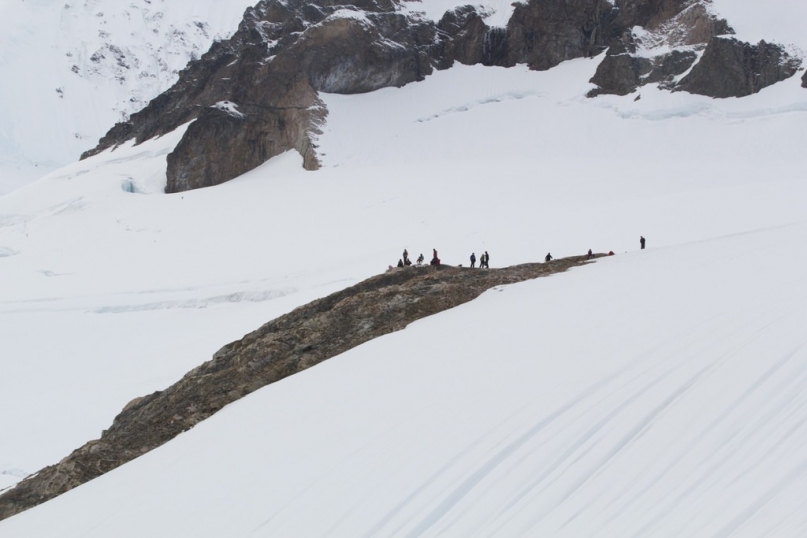
People on an Antarctic mountain. Original photo: 2041 foundation website
Your cause is called “2041”. Why is this such and important year?
“In the year 2041 the International Treaty that preserves Antarctica as a natural reserve for science and peace can be altered or changed or even done away with. My mission is to influence enough (young) leaders by that time and make them aware of the poignant situation. Over the last 14 years I’ve taken 3000 young leaders from 74 nations to visit the Antarctic themselves.”

Playing with light in the Antarctic darkness. Original photo: 2041 foundation website
Visiting Antarctica can be hard and very expensive, but I do believe that if one goes with a responsible tour operator , we choose to work with the most excellent Quark Expeditions , it is ok to visit. As long as it inspires you to become an ambassador for preserving the last great wilderness, of course.
How can I join the cause?
Every year Robert and his team organizes a 11-day expedition to Antarctica where, apart from embarking on an unforgettable journey trough the Antarctic peninsula , you will learn about climate change, sustainability and what we can do to protect the last great wilderness on earth from Robert Swan himself. Anybody can apply, but youngsters under 18 will need to bring a parent or guardian.
Learn about the 2018 itinerary and you can pre-apply for the 2018 expedition through the 2041 foundation’s website.
Below you can see a short (18 minutes) film on last year’s expedition.
Victor Eekhof
Currently in: Amsterdam. Victor’s Travels is a travel blog curated by me, 30-something Dutch world explorer Victor Eekhof. This blog is all about traveling on your own terms and not following the masses . It’s for people who are happiest with a big backpack on their backs and a smaller one on their front; people who walk where others take a cab, or take a bus where others take a plane. I have visited 60+ countries on 7 continents , from Antarctica to North Korea and Venezuela to Russia and started this blog to share my tips and stories with fellow travellers just like you. Read my story »
Explore this travel blog
Mini stories 4: a postcard from the coldest..., working in antarctica: how to find a job..., how to visit antarctica by boat or plane....
I know visiting Antartica might be expensive but I really hope to go one day and it’s so inspiring Roberts mission’s, the video and the idea for people to learn about climate change since it’s so important
Hi Zascha! Yeah I think it’s super important and inspiring too! Have you seen my article on how to get to Antarctica ? That might give you some tips for your trip! 🙂 Victor
Ready for your new adventure?
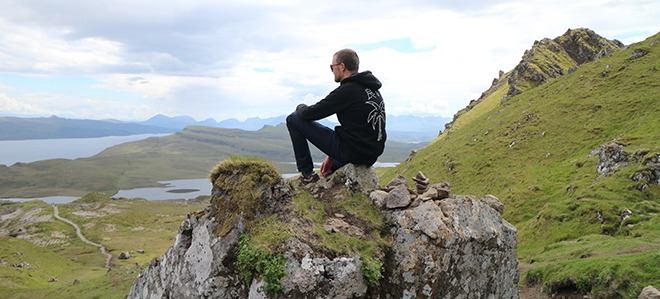
Never miss Victor's budget travel tips, stories, and destination guides by signing up for the monthly newsletter!

14 Best Things To Do In Antarctica To Do On Your Expedition
I f ever given the chance to visit the seventh and arguably the most enchanting continent of Antarctica , take it ! I can assure you there is nowhere on the planet quite like it.
Although you might be thinking Antartica is all just icebergs and penguins, you’d be wrong. In fact, there are many unmissable things to do in Antartica that make it a unique and thrilling destination to adventure to.
After having the chance to spend nearly 15 days on a Chilean Naval Icebreaker with a National Geographic team , we learned there is much to discover and enjoy in the cold continent.
In this guide, we’ve shared some of the top attractions in Antartica and the highlights to experience.
We recommend the Antarctica tours from reputable company G Adventures. Not only will the G Expedition steer you closer to some of our planet’s most amazing places, their professional and highly-skilled team of on-board experts offer keen insight, unique perspectives, and hands-on attention not found in a guidebook. See the G Expedition tours and availability here.
1. Marvel at The Magnificent Landscape At Paradise Bay
2. run the antarctic half-marathon or marathon, 3. lick an iceberg, 4. send a postcard from port lockroy, 5. take a selfie with a penguin (and enjoy the other wildlife), 6. take a helicopter ride for an aerial view of antarctica, 7. take a shot with someone at a research base, 8. check out observation hill for a stunning view, 9. visit the south pole, 10. take a dip in deception island’s hot spring, 11. go kayaking around antartica peninsula, 12. go on a whale watching excursion, 13. do a polar plunge, 14. go snowshoeing, best time to visit antartica, how to get to antartica, final thoughts, 15 best things to do in antarctica.
The Antarctic summer starts in December and runs through till about March. The skies are usually bright and the temperature is no colder than a crisp, sunny winter’s day.
The summer is the best time to see Antarctica at its most beautiful, and arguably the best place to witness the beauty of Antartica’s landscapes is at the pristine Paradise Bay .
Paradise Bay is on the West side of Antarctica and the still waters and fascinating icebergs make it the epitome of Antarctica.
Visiting this harbor is simply put— magical.
On a typical summer day you would see exquisite ice sculptures standing tall and majestic, clear skies reflecting all the mightiness of the mountains into the clear bay.
Albatrosses spreading their 11ft wings and filling the skies as leopard seals bask in the sun on an ice float. Time stops still here .
The beauty is breath taking and is the go-to place if you want to experience the magical wonder that is Antarctica!
Read more: How To Visit Antartica on a Ross Sea Expedition.
On King George’s Island in nearly sub-zero conditions there are the Antarctic Half-Marathon and Marathon for those that are the most hardcore!
How great would finishing a race with a nice little medal be, to commemorate the trip to Antarctica?
The first things that I noticed when entering Antarctic territory were the beasts that were the icebergs.
They speckled the water and stood tall against the clear sky. It had always been on my bucket list to lick a real iceberg and where better to cross this off my list than in Antarctica!
Icebergs are never still and are constantly shifting positions due to the wind. For this reason a lot of bigger ships tend to steer clear of these ‘bergs. No one wants a repeat of the Titanic!
The chances come with smaller vessels, primarily Zodiacs . They are must smaller and can navigate around icebergs with ease.
We had the chance to pull up next to a rather small iceberg and see how far into the water it actually went. The old adage is true, what we saw really was “just the tip of the iceberg!”
Getting exciting at the possibility of being able to lick one of these great ice blocks we convinced our zodiac driver to pull in between two icebergs. Needless to say, this was a bad idea.
The imperceptible motions of the icebergs were lost on us and soon we found ourselves trapped between them.
Luckily, a flatboat from a base was returning to shore when they spotted us and were able to aid in our rescue!
If you stop by Port Lockroy make sure to send yourself a cool postcard stamped from Antarctica.
The Port Lockroy Museum used to be the British Base but is now a full time post office.
It is a cute little structure from which you can send yourself mail stamped with Antarctica’s stamp!
The best place to enjoy the frolicking of penguins would be on Paradise Bay . The snow capped mountains in the background with the little creatures in tuxedos happily scampering about is quite a sight.
They love to slide around on their bellies and splash around in the water. Their squawking and cooing is a pleasurable cacophony. Here is the ideal place to watch them play and take photographs.
The penguins on Antarctica aren’t used to humans but they sure aren’t scared of us either. They happily run up to you and circle your feet.
There are several species of penguin in Antartica, such as King Penguins, Gentoo Penguins, and Emperor Penguins. The penguins at Paradise Bay are Gentoo Penguins.
In terms of wildlife there is more to see than just penguins. Sometimes Leopard Seals, Elephant Seals, Fur Seals and Weddell Seals beach themselves on shore to relax after a meal, or even to lie in wait for the oblivious penguins to walk within reach.
These creatures aren’t used to humans either but they are not as friendly as the penguins.
We were advised by the people from the base and the National Geographic Team to leave the seals (and any other creature that wasn’t a penguin) alone, for our own safety.
In fact, it’s not a good idea to pick up or touch the penguins either. Many people do, but it’s not ethical practice and may frighten the penguin so we don’t advocate for this.
It is breathtaking to get an aerial view of Antarctica and its magnificent landscape.
Using a helicopter is probably the best way to travel around the continent and witness the Emperor penguin colonies, or even fly amongst albatross.
A popular spot to fly over is the Weddell Sea region, which is known for its wildlife.
You may also be in with a chance of seeing humpback whales, orcas, right whales swimming in the ocean, or see seals basking on ice floes.
It’s an odd thing when you ask someone where home is and their answer is Antarctica.
This is quite the case for the roughly 4,000 people that call Antarctica home during the summer months and the 1,000 that stay there during the winter as well!
Having a look into a base you wouldn’t even realize that you were on Antarctica. In fact, there are 70 permanent bases on the continent, each belonging to a different country – though not all of them are open to the public.
There’s a rather up-to-date facility at Base O’Higgins, a base belonging to Chile. They are staffed with all the amenities one could hope for including a basketball court!
Some other research stations you can visit as a tourist are Vernadsky Station , which is owned by Ukraine, Brown Station , Carlini Base , and Cámara Station which belong to Argentina .
So go ahead, be bold, as to take a shot (whether a drink or with a camera) with a person from within one of these awesome bases.
If you’re looking for an incredible view of the snowy peaks and icebergs, then head to the McMurdo Station and trek up Observation Hill .
It is not that much of a trek from the station (roughly 30-40 minutes) with an elevation of 754-foot (230 meter), but the view from the top is stunning. Though be warned, it’s a steep trek!
There is a beautiful view of the Ross Ice Shelf and views of Mt. Erebus ; the perfect spot for quiet reflection.
The South Pole lies at 90°S and 0°W . The best way to access this point is via helicopter, because it’s quicker and safer.
However, you can also reach the South Pole by trekking. The trek is not for the faint hearted though – you need to be equipped with specialized polar gear, designed to withstand the harsh conditions of the icy continent.
You can also reach the South Pole by vehicle.
Standing at the South Pole is how one can claim that they have indeed reached all the way to the bottom of the Earth. You can also visit the US Scientific research base known as the Amundsen – Scott South Pole Station.
Another bucket list thing to do in Antartica is experience the joy of bathing in a hot spring in Antarctica. Yes, you heard me! Strip down and swim around in warm Antarctic waters!
On Deception Island , at the South Shetlands in Antarctica , there is warm volcanic soil and even warmer water underground. This is because the island sits in a caldera above an active volcano.
If you’re feeling particularly brave you can wade into the warm shore water or else just dig up some of the volcanic soil and climb into a steaming hot pool of water right on Antarctica’s mainland!
One of the best ways to see Antartica is to get out on the water. Grab your paddles and life vest, and kayak around the icebergs and sheets of glacial ice.
While most cruise expeditions will have smaller zodiac cruises that take you to land, a kayak tour is a great way to get up close and personal with the landscape and wildlife.
While you might be anxious about the water conditions, the water around the Antarctic Peninsula is usually very still and calm, since it’s protected by the glaciers.
Sometimes it’s even possible to be greeted by curious whales in the waters.
Check out kayak tours in Antarctica here!
Not trip to Antarctica would be complete without taking a whale-watching adventure to see these majestic creatures in their natural habitat.
Antarctica boasts an abundance of whale species, including humpback, orca, minke, and blue whales. The sheer size and grace of these magnificent animals as they breach, tail-slap, and swim alongside your zodiac vessel is a sight to behold.
Not only do you get to witness their behavior, but you can learn about their conservation needs through expert guides and educational lectures onboard your expedition vessil.
Does the idea of taking a dive in cold water scare you? That’s exactly why you should do it!
The most thrilling thing to do in Antarctica is to take a cold plunge. This is when you strip down to your swimsuit, attach a safety rope around your waist, and dive in.
Sometimes shots are supplied so you can warm your insides up before and after. After all, you may need to be a little tipsy to take this challenge on!
Another great way to see the landscape of Antartica is to for a hike in snowshoes.
Imagine strapping on snowshoes and traversing through vast expanses of untouched snow, surrounded by towering glaciers, majestic mountains, and an endless white horizon.
It’s a chance to immerse yourself in the serene beauty of Antarctica, exploring areas inaccessible by other means.
The best time to visit Antarctica is during the summer, which runs from November to March.
During this time, the temperatures are relatively mild, ranging from -2°C to 8°C (28°F to 46°F).
The days are longer, with up to 20 hours of daylight, allowing for more time to explore and admire the stunning landscapes.
Wildlife is also abundant during this period, with penguins, seals, and whales being easily spotted.
The best time to see nesting penguins and baby penguins hatching is from November and early December, while late February and March are the best months to do whale watching as they migrate through the Drake Passage.
Antartica isn’t a destination where you can simply book a flight and go. There’s only one way to visit the continent as a tourist, and that’s on an Antarctic Cruise or by joining as a volunteer/research on an Antarctic Expedition.
Before booking a cruise expedition, be sure to research reputable tour operators.
Most travelers reach this icy paradise by boarding a cruise ship from Ushuaia, Argentina, which serves as the gateway to the Antarctic Peninsula and the Falkland Islands.
Alternatively, some opt for fly-cruise options, where they first take a flight to Punta Arenas, Chile, before boarding a ship.
It’s important to choose a voyage that suits your preferences and budget, though the cheapest cruise that we’ve come across is still around $4000 USD per person for ten days.
Note that the only way to reach Antarctica is to sail through Drake Passage, a notoriously rough section of ocean where waves can reach 12 meters (40 feet). Be sure to pack plenty of motion sickness tablets.
So there you have it, those are the best things to do in Antartica, and as you can see, there’s a lot of cool things to see and do.
Since most people visit Antartica as part of a cruise, be sure to check out what excursions and activities they have planned to help you decide on what to do.
Some cruises have workshops and educational talks, as well as additional excursions you can take.
The beauty of visiting Antartica is that much of the planning is done for you when you purchase an expedition package, but we hope this guide gave you some inspiration for what activities to look for when booking an expedition.
Have you been to Antarctica before? Is it on your bucket list now? Let us know in the comments.
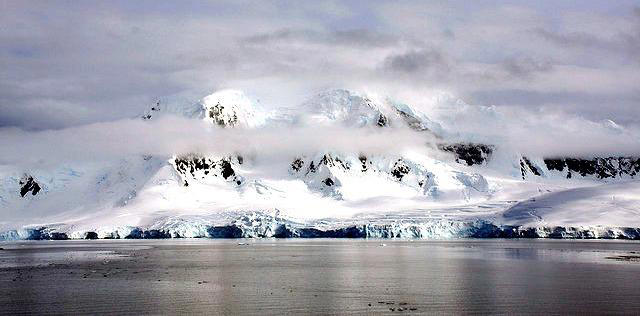
Don’t Give Up on Tourism. Just Do It Better.
Paige McClanahan’s book, The New Tourist , argues for recognizing how potent travel’s social force is.

In 1956, the poet Elizabeth Bishop worried about the imprudence and absurdity of going abroad. “Should we have stayed at home and thought of here?” she writes in her poem “Questions of Travel.” “Is it right to be watching strangers in a play / in this strangest of theatres? / What childishness is it that while there's a breath of life / in our bodies, we are determined to rush / to see the sun the other way around?”
Decades later, the phrasing of these questions, and the fretful frame of mind behind them, seems to perfectly sum up a new attitude toward international travel: one of moral unease. Every summer, a litany of headlines appears about tourists behaving badly: people carving their names into the Colosseum or posing naked at sacred sites in Bali , for example. Even the ordinary business of tourism leaves much to be desired: The crowds at the Louvre make seeing the Mona Lisa such a brief and unsatisfying experience; foot traffic, noise, and trash slowly degrade sites famous for their natural beauty or historical significance. In the Canary Islands, the Greek island of Paros, and Oaxaca, Mexico, residents of popular destinations have protested against throngs of visitors. For many travelers, it can seem somehow wrong , now, to plunge blithely into another country’s culture and landscapes, subjecting locals to one’s presence for the sake of leisure, while the long-haul flights that make these trips possible emit massive amounts of greenhouse gases. Bishop’s queries are our own: Would we be doing the world a favor if we didn’t sally forth so confidently to other countries and just stayed home?
Amid this quagmire, the journalist Paige McClanahan’s book, The New Tourist , is a levelheaded defense of tourism that proposes a genuinely helpful framework for thinking about our own voyages. We tourists—a label that includes everyone who travels abroad for work or fun—think about the practice’s pleasures all wrong, she says, and discount its potential. Many of us are used to thinking of ourselves as simple hedonists when we go on vacation, or perhaps as economic participants of the tourism industry. But we’ve largely forgotten “about the power we hold as contributors—however unwitting—to a vast and potent social force,” McClanahan writes.

The New Tourist is dedicated to fleshing out this bird’s-eye view of tourism as a formidable phenomenon, one that we participate in every time we leave our home country—and one that we ignore at our peril. Traveling the world was once reserved for the very rich; now, thanks to a series of recent developments—including the deregulation of the airline industry in 1978 and the launch of Travelocity and Expedia in the ’90s—planning a trip to Iceland or even Antarctica is easier than ever. The world saw more than 1 billion international tourist arrivals last year, and tourism contributed nearly 10 percent to global GDP. This monumental traffic now shapes the world for both good and ill, as McClanahan demonstrates. Tourism revitalized the city of Liverpool and employs nearly a quarter of the workforce of the Indian state of Kerala; it’s also turning places such as Barcelona’s city center and Amsterdam’s red-light district into miserable, kitschy tourist traps and pricing out local residents.
Read: A future without long-haul vacations
Tourism also has the capacity to shape how travelers imagine other countries. McClanahan dedicates an entire chapter to soft power—a government’s political ability to influence other states—because, as she points out, our travels change where we’re likely to spend our money and “which places we’re inclined to regard with empathy.” Tourism has elevated Iceland, for instance, from a country that North Americans knew little about to a recognized player on the world stage. And Saudi Arabia plans to pour hundreds of billions of dollars into its tourism industry with a goal of attracting a planned 150 million visitors a year by 2030. For a nation, especially one striving to change its international reputation, the benefits of tourism aren’t merely financial. “The minute you put your feet on the ground,” an expert on “nation branding” tells McClanahan, “your perception starts changing for the better—in ninety percent of cases.”
In fact, McClanahan took a trip to Saudi Arabia as research for this book. “I was scared to go,” she writes, given what she’d read about the country’s treatment of both women and journalists, “more scared than I’ve been ahead of any trip in recent memory.” But she was captivated by her conversations with Fatimah, a tour guide who drives the two of them around in her silver pickup truck. Over the course of the day, they discuss the rights of Saudi women and the assassination of the journalist Jamal Khashoggi. “Her answers are thoughtful; many surprise me, and I find myself disagreeing with several outright,” McClanahan writes. When McClanahan returned home and published an interview with Fatimah for The New York Times, however, outraged readers excoriated her. “Just curious—how much did MBS pay you to tourism-wash his country?” one wrote to her in an email, referencing Saudi Crown Prince Mohammed bin Salman. “Or was the payment done strictly in bonesaws?”
McClanahan likens these commenters to acquaintances who tell her they refuse to visit the U.S. because they’re disgusted by some aspect of our country—American stances on abortion, or immigration, or race. Traveling to Saudi Arabia didn’t change her awareness of the country’s repression of speech and criminalization of homosexuality. But it did give her “a glimpse of the breadth and depth of my ignorance of the place,” and a recognition that the country has to be viewed with nuance; in addition to its regressive policies, she writes, the trip made her acknowledge the complexity of a land that millions of people call home.
Read: The fantasy of heritage tourism
McClanahan’s anecdote gestures at what we might gain from tourism—which, she argues, has now become “humanity’s most important means of conversation across cultures.” What physically traveling to another country grants you is a sense of how ordinary things are in most parts of the world. Unless you’re limiting yourself to the most touristy spots, going someplace else plunges you briefly into a daily fabric of existence where you must navigate convenience stores and train schedules and local currency, surrounded by other people just trying to live their lives—a kind of visceral, cheek-by-jowl reminder of our common humanity, distinct from the policies of a group’s current ruling body. Traveling, McClanahan suggests, helps people more keenly discern the difference between a state’s positions and the culture of its people by seeing it with their own eyes. This firsthand exposure is a much better reflection of the truth than flattened, extreme images provided by the internet and the news. That’s a good thing, because by sheer numbers, this kind of cross-cultural contact happens on a much larger scale than any other.
Seeing the wide world more clearly seems beneficial for everyone involved. But measuring these grand ideas about travel against its actual effects can be difficult. How exactly does visiting new places change you? Can a short trip, especially one catered to a foreign visitor, really give a person a realistic view of life in another country? McClanahan doesn’t specify what she and Fatimah disagreed or agreed on, or what aspects of Saudi Arabia she was ignorant of and subsequently learned on her trip. In the Times article, Fatimah’s answers about what it’s like to be a Saudi woman who drives, wearing no head scarf or abaya, are uniformly breezy—“Some people might stare because it’s still kind of a new thing to see, but they respect my choice,” she says—and a reader might wonder if, as an ambassador for a more liberal Saudi Arabia, she’s motivated to respond that way. One could argue that by not pressing further, McClanahan actually avoids Saudi Arabia's complexity. And this surface-level experience extends to all kinds of trips: When I travel, I’ve found that the notion that I’m doing something good—not just for me, but for the world —can seem impossibly lofty, even self-aggrandizing, amid my stress, exhaustion, and vague shame. How valuable is enlightenment about my own ignorance compared with the concrete harm of emissions and supporting states with unjust laws?
And yet this tension is the crux of the soft-power argument: How people feel about other places matters, because these opinions shape reality. Dismissing these intangible sentiments raises the risk of falling into the old trap of seeing travel through an individual lens rather than a social one. What might happen if millions of humans have their perspectives of other nations subtly changed? Perhaps, McClanahan suggests, we’d gain the ability to exist alongside different worldviews with equanimity, without alarm or intolerance—a necessary skill for democracy and peace, and an outcome worth the downsides of mass tourism.
Read: The last place on Earth any tourist should go
But to encourage this global-citizen frame of mind, governments, businesses, and tourists alike have to change the way the travel industry works. If we are to consider tourism a collective phenomenon, then most of the burden to improve it shouldn’t fall on individuals. “Tourism is an area in which too many governments only get the memo that they should pay attention after too much damage has been done,” McClanahan writes. (Her book is full of examples, like the poignant image of visitors trampling natural grass and moss around a popular canyon in Iceland so badly that the landscape may take 50 to 100 years to recover.) Instead, she argues, lawmakers should enact regulations that help manage the influx, and she lists concrete steps they can take: setting capacity limits, building infrastructure to accommodate traffic, banning short-term rentals that drive up prices across the world, and making sure that most of the money and other benefits flow to local residents.
But the social lens also suggests that there are better and worse ways to be a tourist. Traveling will always be personal, but we can shift our behavior to acknowledge our role in a broader system, and also improve our chances of having a meaningful experience. McClanahan sketches out a spectrum with two contrasting types at the ends, which she politely (and optimistically) dubs the “old” and “new” tourist. The old tourist is essentially the boorish figure from the headlines—solipsistic, oriented toward the self, someone who superimposes their fantasies onto a place and then is outraged when their expectations aren’t met. What sets apart the new tourist is a focus on the place they’re visiting. Don’t make it about you, in short: Make it about where you are .
Traveling well, then, involves basic acts of physical courtesy: Don’t litter, don’t cross barriers intended to protect wildlife, don’t take fragments of beaches or ruins, and generally don’t be a nuisance. But it also involves some amount of research and critical thinking about the destination itself. I’ve taken to using my international trips as crash courses in the history of a particular country, which mostly means reading books and spending large amounts of time at museums and historical sites. But this is just what I happen to enjoy. One could just as profitably try picking up the language, having conversations with residents about their lives (if they seem interested in talking to you, of course), venturing to less well-known destinations, or reading the country’s newspapers and learning what issues people care about. The point is to invest something of oneself, to try to engage with a different place—an effort that strikes me as a more honest accounting of the undeniable costs of going abroad. Even Bishop concludes, in “Questions of Travel,” that the endeavor is ultimately worthwhile. “Surely,” she writes, “it would have been a pity / not to have seen the trees along this road, / really exaggerated in their beauty, / not to have seen them gesturing / like noble pantomimists, robed in pink.”
When you buy a book using a link on this page, we receive a commission. Thank you for supporting The Atlantic.

IMAGES
VIDEO
COMMENTS
As tourist numbers have grown, operators have moved to offer activities like kayaking. Shutterstock How did Antarctic tourism go mainstream? In the 1950s, the first tourists hitched rides on ...
Between 1992 and 2020, the number of tourists arriving increased ten-fold, rising to 75,000 in the 2019-20 season and again to 104,897 in the 2022-23 season. Antarctic tourism has both positive and negative impacts. The Antarctic tourist experience can be both inspirational and educational, fostering public support and investment for the ...
December: December is excellent for warmer weather and seeing penguin chicks! Many would say that December is the best month to visit Antarctica. Temperatures are getting warm (by Antarctica standards, that is). The sun barely sets, so you get long days, and the wildlife is at its most active.
And more people than ever are in Antarctica because tourism is on a tear. Four decades ago, the continent saw only a few hundred visitors each summer. More than 100,000 people traveled there this ...
More than 56,000 tourists visited Antarctica during the 2018-2019 season. The figure for the current season is expected to rise to more than 78,500, more than double the total from a decade ago ...
Learn about the environmental benefits and challenges of visiting Antarctica, a continent with no native residents. Find out how tourism can educate, protect, and disrupt the wildlife and ecosystems of this remote land.
Responsible Travel in Antarctica: Protecting the Integrity of the White Continent. There are both positive and negative impacts of tourism in Antarctica, as anywhere. Experiencing the White Continent firsthand—its fluted icebergs, looming ice-shelves, seal colonies, penguin towns, ice-armored summits, whale-plowed leads and bays—inspires ...
It mandates "Antarctica shall be used for peaceful purposes only," all scientific results must be publicly shared, and there shall be no military activity, no nuclear testing, or territorial claims to the land. Since the signing of this treaty on December 1, 1959, in Washington, DC, by 12 countries, an additional 42 nations have become part ...
There are two big obstacles to getting to Antarctica this year. One is the lack of cruises - most operators have cancelled their schedules for the remainder of the this year and early next year. If cruises can happen at all this season it will be towards the end of the usual period of operation. Hurtigruten has cancelled Antarctica departures ...
Antarctica: a great trip, not a guilt trip. CNN —. Two things on the rise in the Antarctic peninsula: temperatures and tourism. An unprecedented 17.5 C (63.5 F) was recorded by the World ...
Last year, for the first time, more than 100,000 tourists visited Antarctica. That figure is expected to increase in 2024. It is in stark contrast to visitor numbers during the global pandemic when only two ships and 15 people ventured to the southern wilderness in the name of tourism. Leslie Hsu, a freelance journalist and award-winning ...
Under the Antarctic Treaty, tourist and scientific operators are required to remove waste from the continent. Trash and human waste are flown or shipped off the continent for disposal at warmer latitudes. But some forms of waste are not so easily squirreled off the continent. All activity in Antarctica - be it powered drills for scientific ...
That said, if you want to visit Antarctica on a traditional cruise line, many major carriers can get you there — often on vessels that adhere to that fewer-than-200-guests rule of thumb. Some ...
During the COVID summer of 2020-21, just 15 tourists on two yachts visited Antarctica. But now, tourism is back—and bigger than ever. This season's visitor numbers are up more than 40% over the ...
8. For Science. Another popular reason to visit Antarctica is from a scientific perspective. Antarctica is one of the most untouched locations in the world thus making it a prime destination for those studying climate change, paleontology (plants & fossils) and is also a top spot for astronomers to study the sky.
Antarctica's biggest industry is tourism, with over 56,000 visitors per year, some 10,000 of whom will only cruise or fly without setting foot on land. Currently, most of this tourism is concentrated in just 2 percent of the Antarctic - the Antarctic Peninsula - and is spread over just five months of the year, so effects on the ...
Tourism to Antarctic coastal areas began in the late 1950s with Chile and Argentina carrying a few hundred fare-paying passengers to the South Shetland Islands. The first expedition to Antarctica with travellers was in 1966 and was lead by Lars Eric Lindblad. ... Depending on the site visited and time of year, there can be between 1-3 landings ...
Antarctic sea ice cover hit record lows in 2017, 2022, and 2023. Credit: NCPOR. Amid geopolitical shifts and decreasing sea ice 1, parties to the Antarctic Treaty are moving to regulate tourism on ...
This season 37,000 tourists are expected in Antarctica, although 10,000 will never go ashore. About half the tourist ships are, like ours, flagged to Antarctic Treaty countries making them legally ...
You might think the highest, driest, coldest and most remote continent in the world would be immune to over-tourism. But Antarctic visitor numbers are on the rise (up 17% to 51,000 people in 2018). ... There are certain environmentalists that would say the best way to protect Antarctica is not to travel there at all. That, simply by visiting ...
There have been many debates as to whether there should be tourism in Antarctica. Not surprisingly, both conservationists and tour operators have put together good evidence to support their own arguments. Firstly, conservationists believe that tourism could damage Antarctica's environment and wildlife. Unfortunately, ships that travel to and ...
Tourism in Antarctica. Tourism started in Antarctica by the sea in the 1960s. Air overflights started in the 1970s with sightseeing flights by airliners from Australia and New Zealand, and were resumed in the 1990s. The (summer) tour season lasts from November to March. Most of the estimated 14,762 visitors to Antarctica from 1999-2000 were ...
A personal perspective on the pros and cons of visiting Antarctica, with tips on responsible travel and environmental impact. Learn about the 2041 foundation's mission to save Antarctica and how you can join their expeditions.
There's only one way to visit the continent as a tourist, and that's on an Antarctic Cruise or by joining as a volunteer/research on an Antarctic Expedition.
The world saw more than 1 billion international tourist arrivals last year, and tourism contributed nearly 10 percent to global GDP. This monumental traffic now shapes the world for both good and ...